The document provides an introduction and overview of the Python programming language. It discusses that Python is an interpreted, object-oriented, high-level programming language that is easy to learn and read. It also covers Python features such as portability, extensive standard libraries, and support for functional, structured, and object-oriented programming. The document then discusses Python data types including numbers, strings, and various Python syntax elements before concluding with brief descriptions of Python versions and key changes between Python 2 and 3.
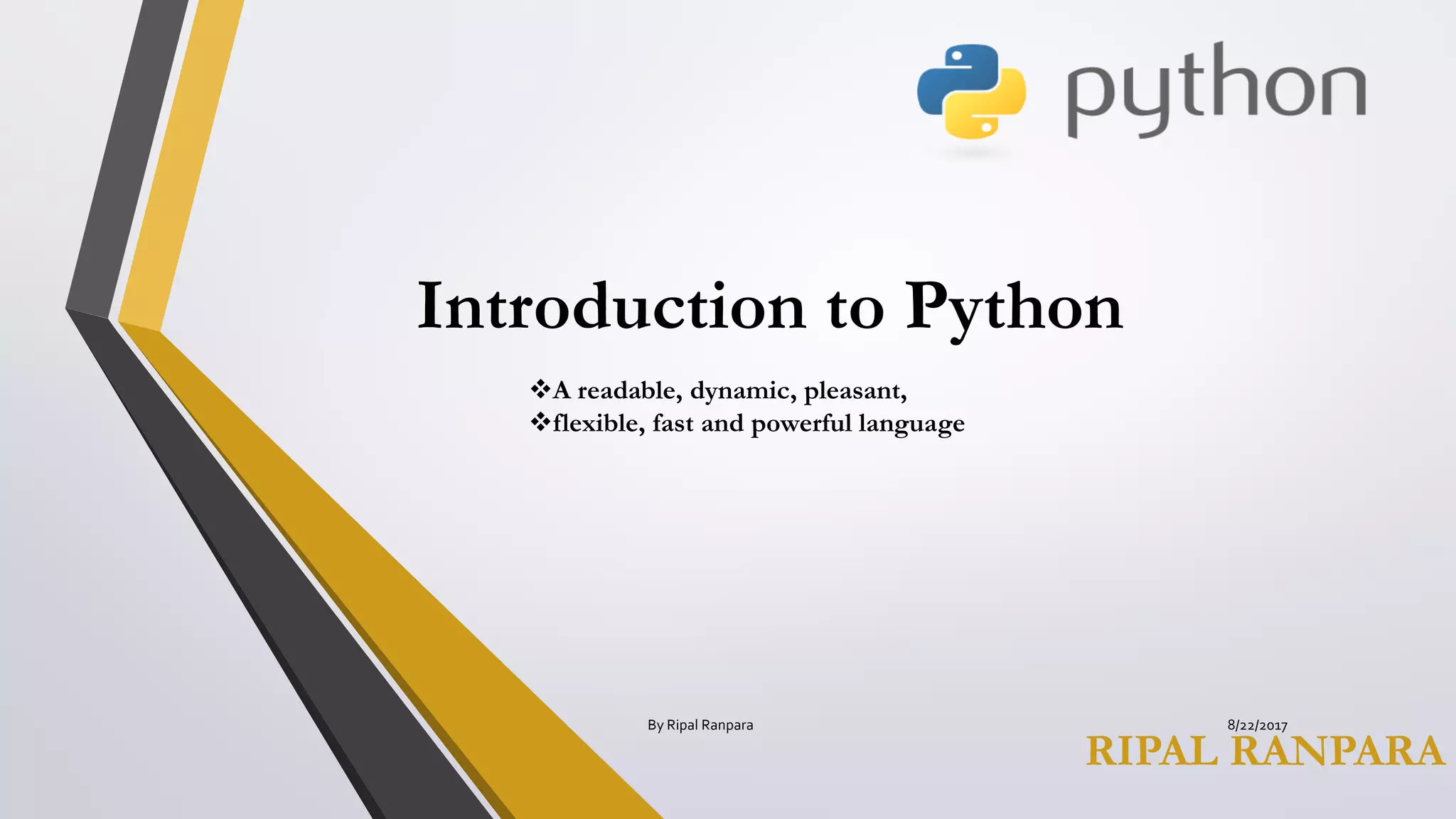

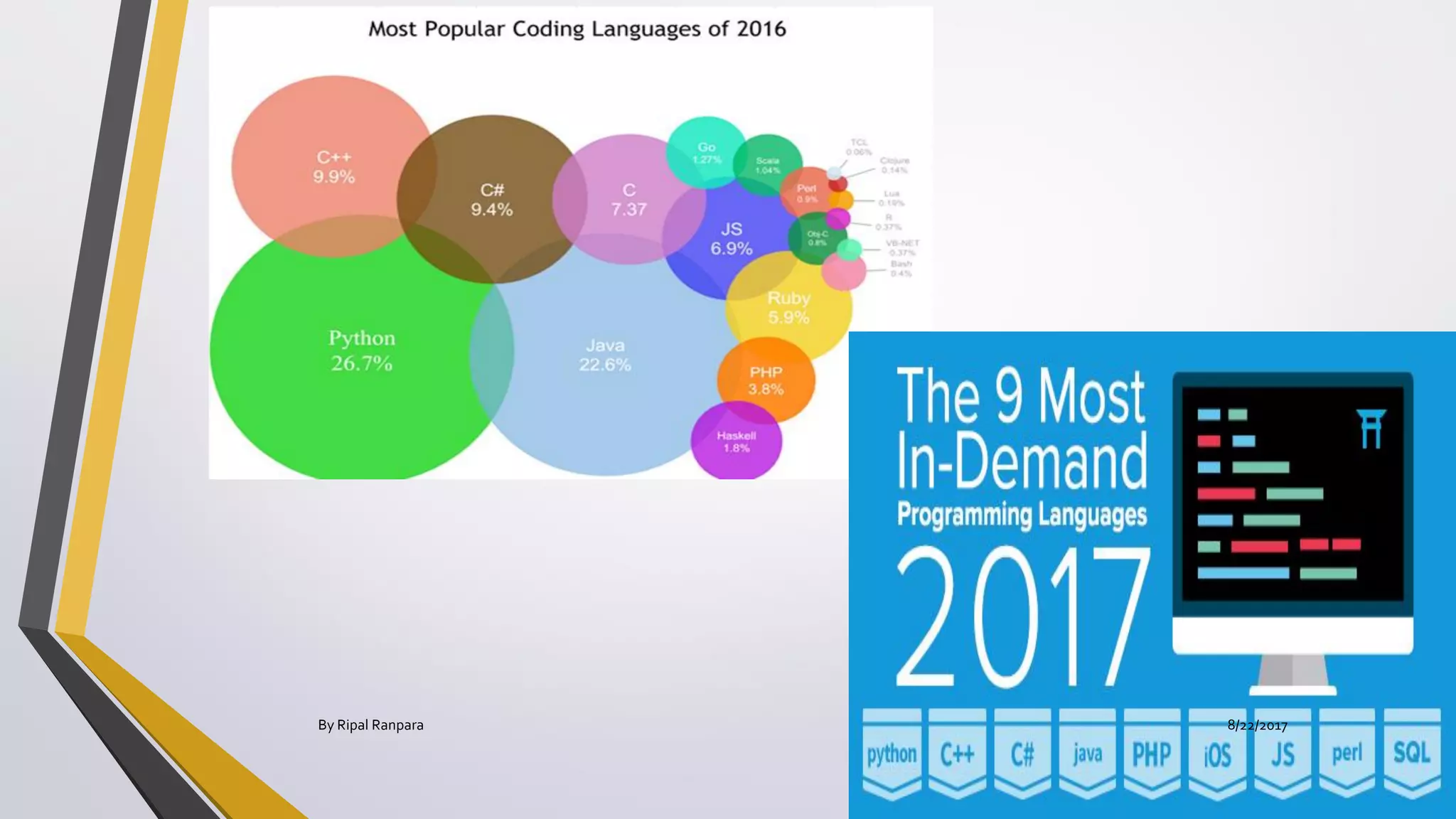
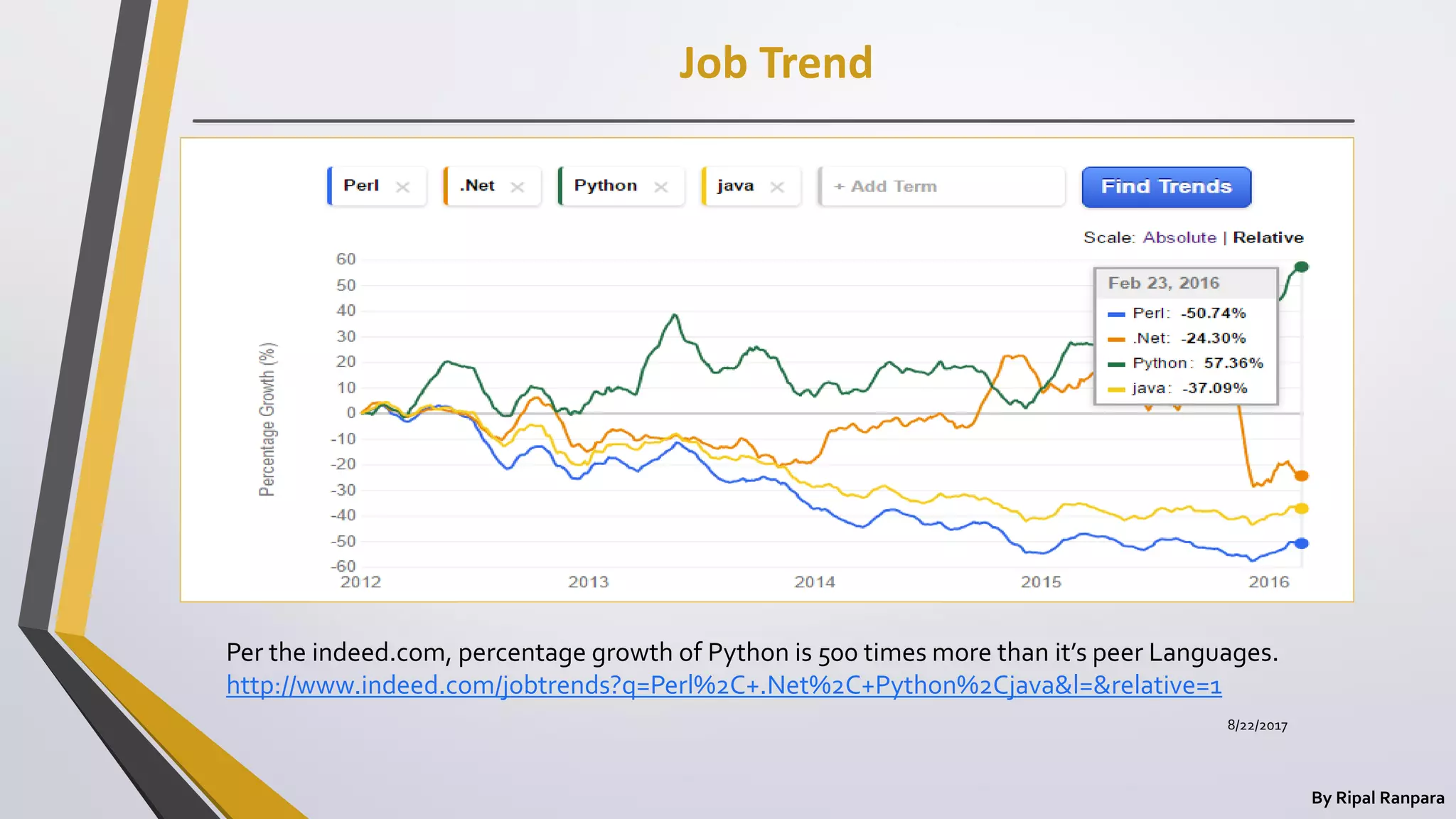
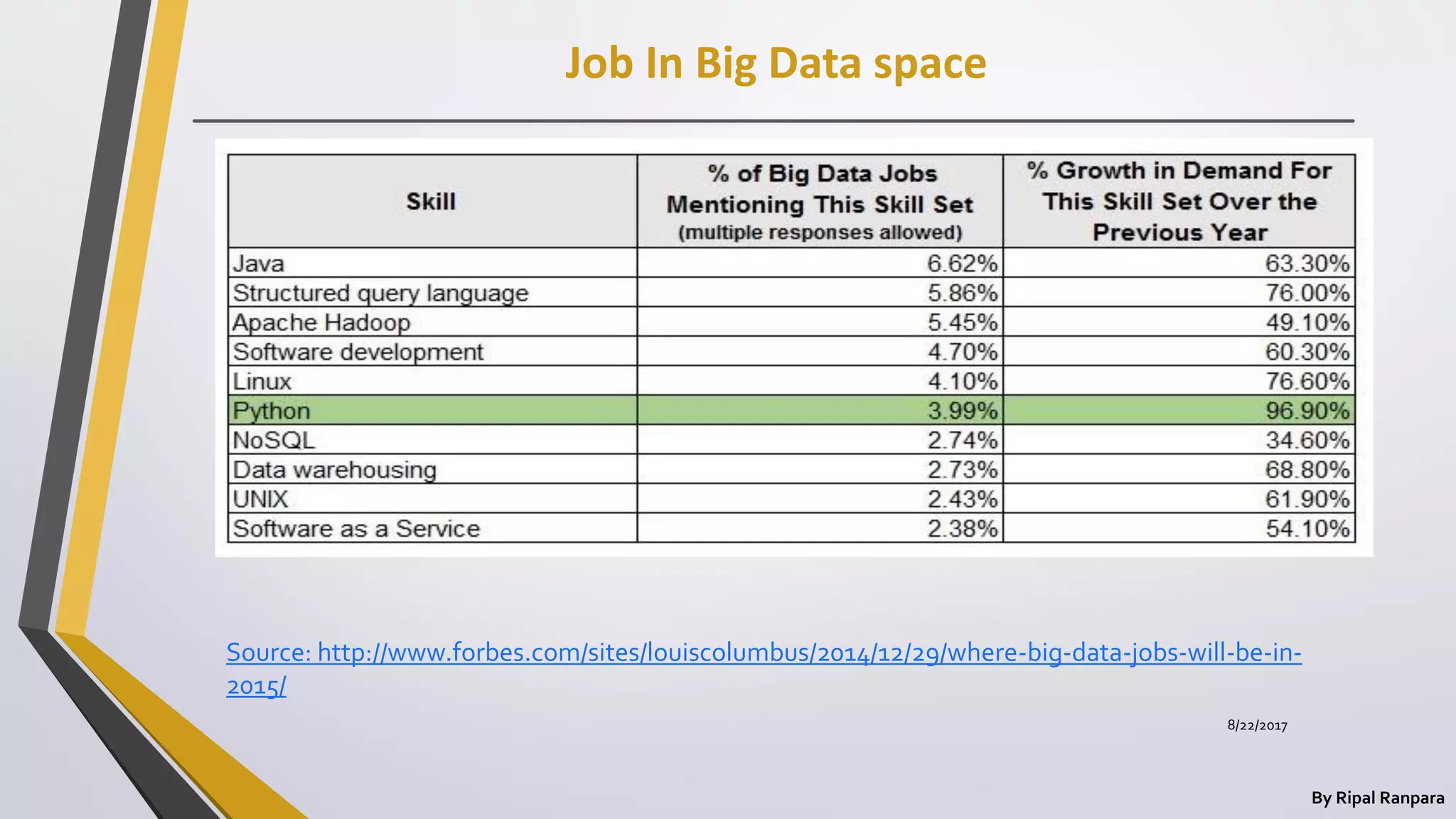


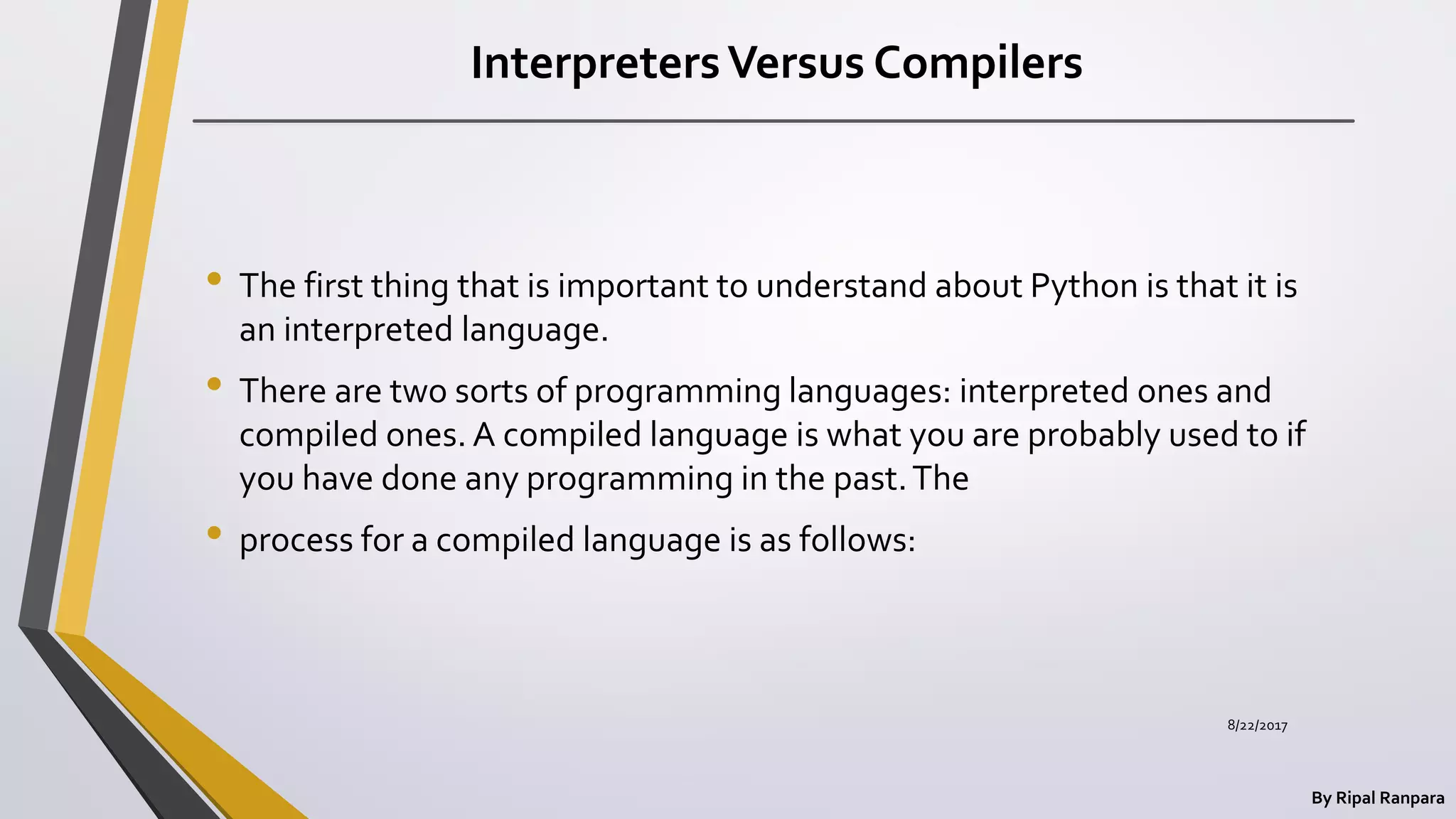
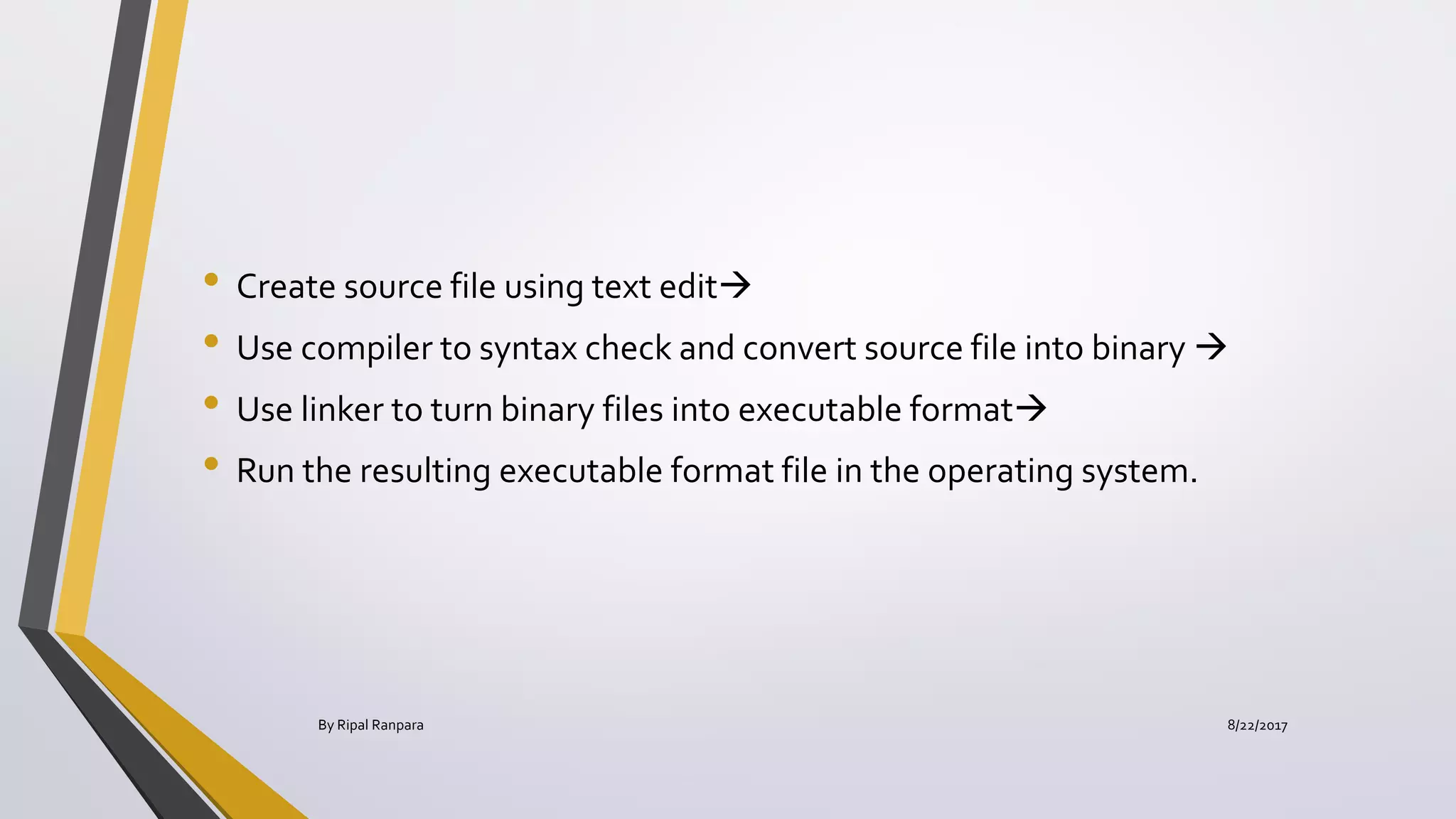
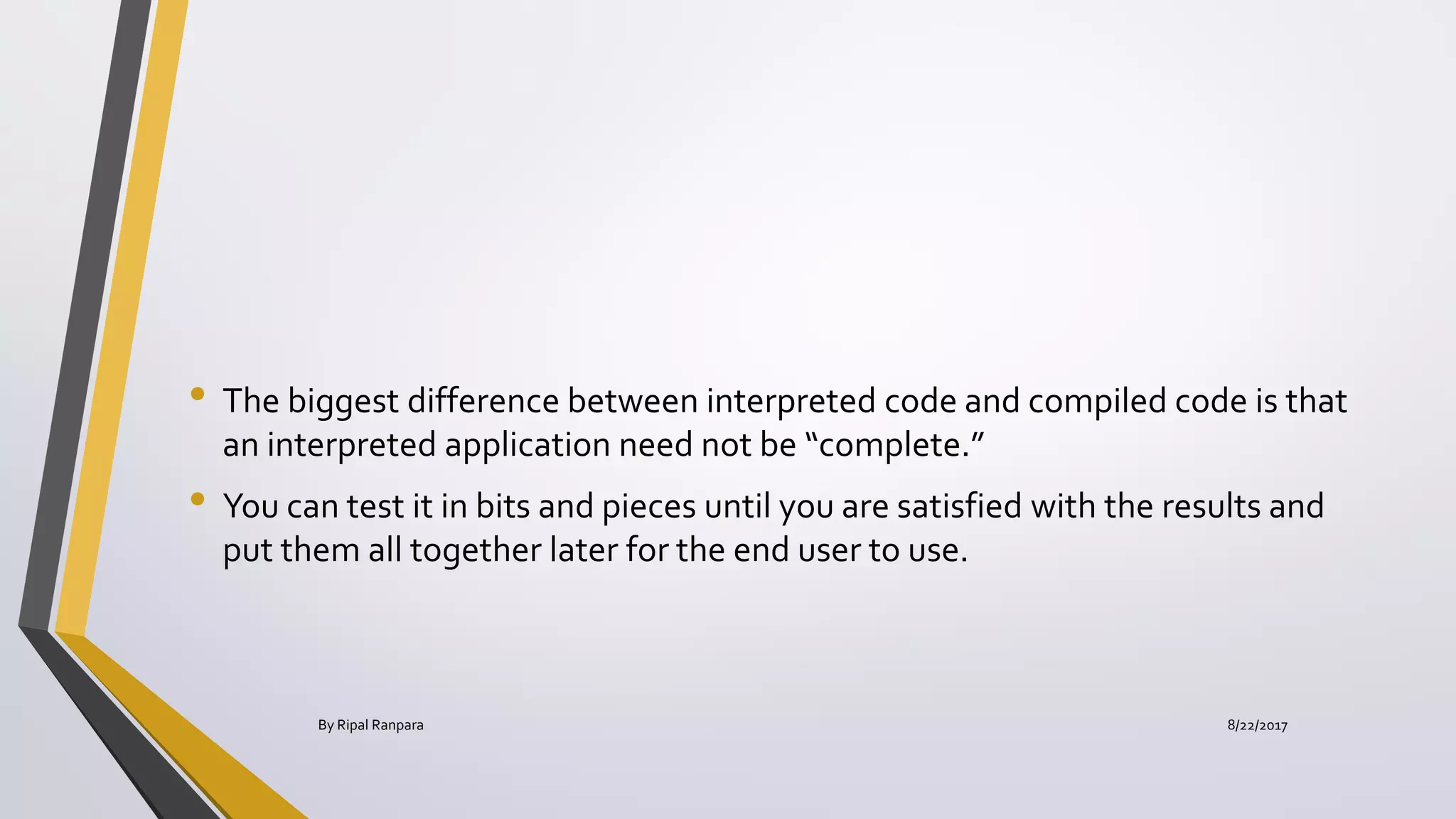
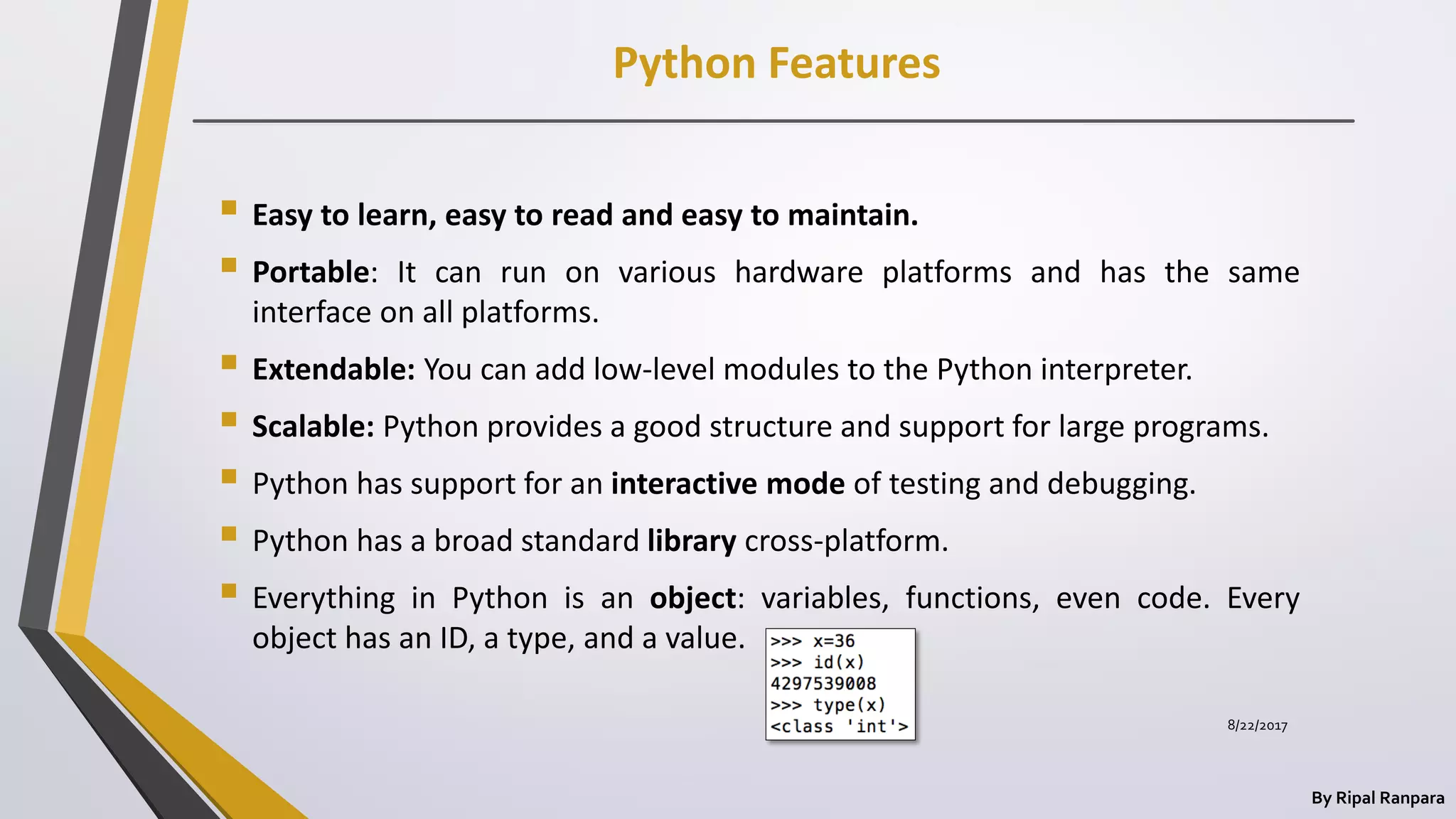
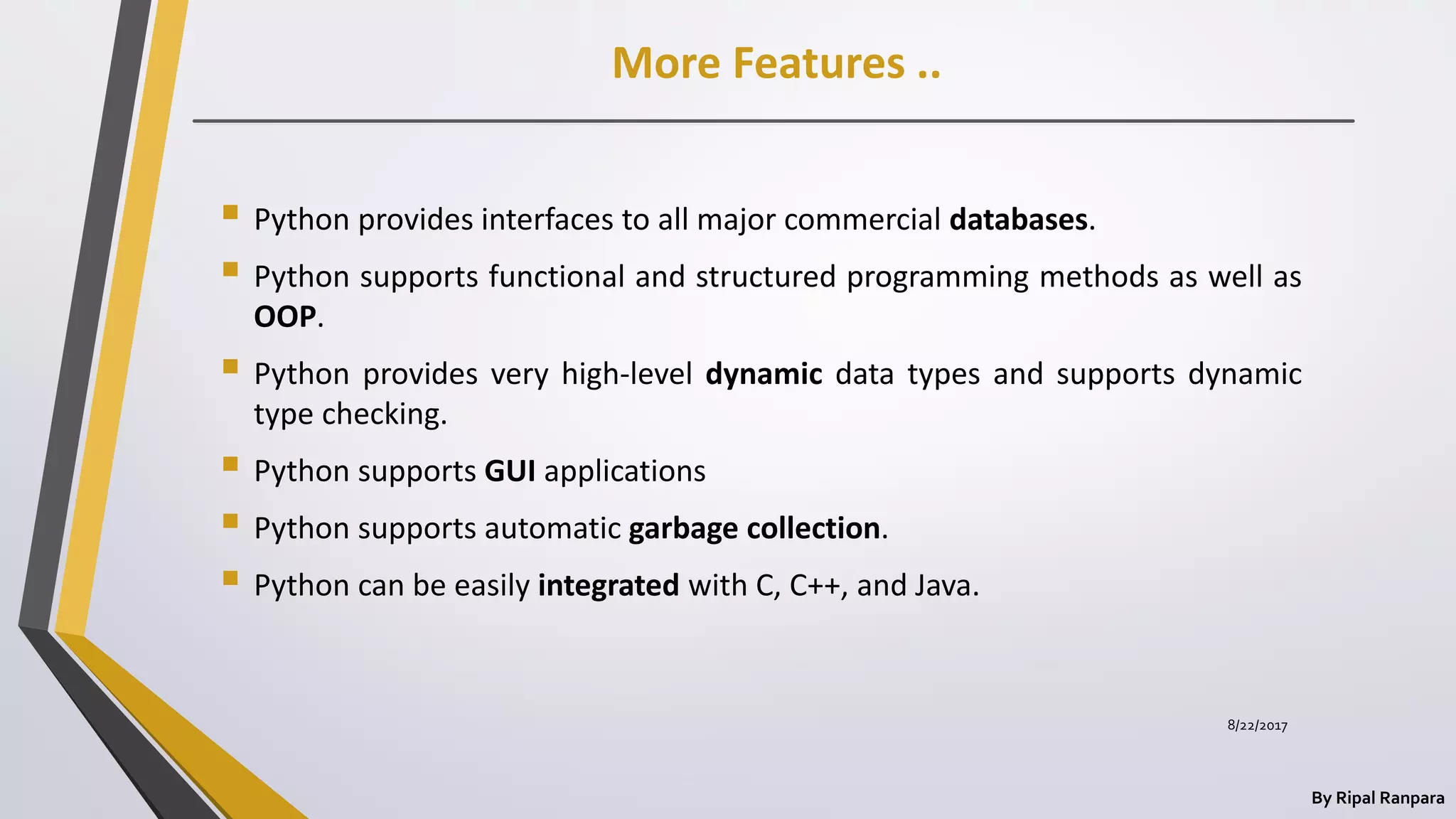



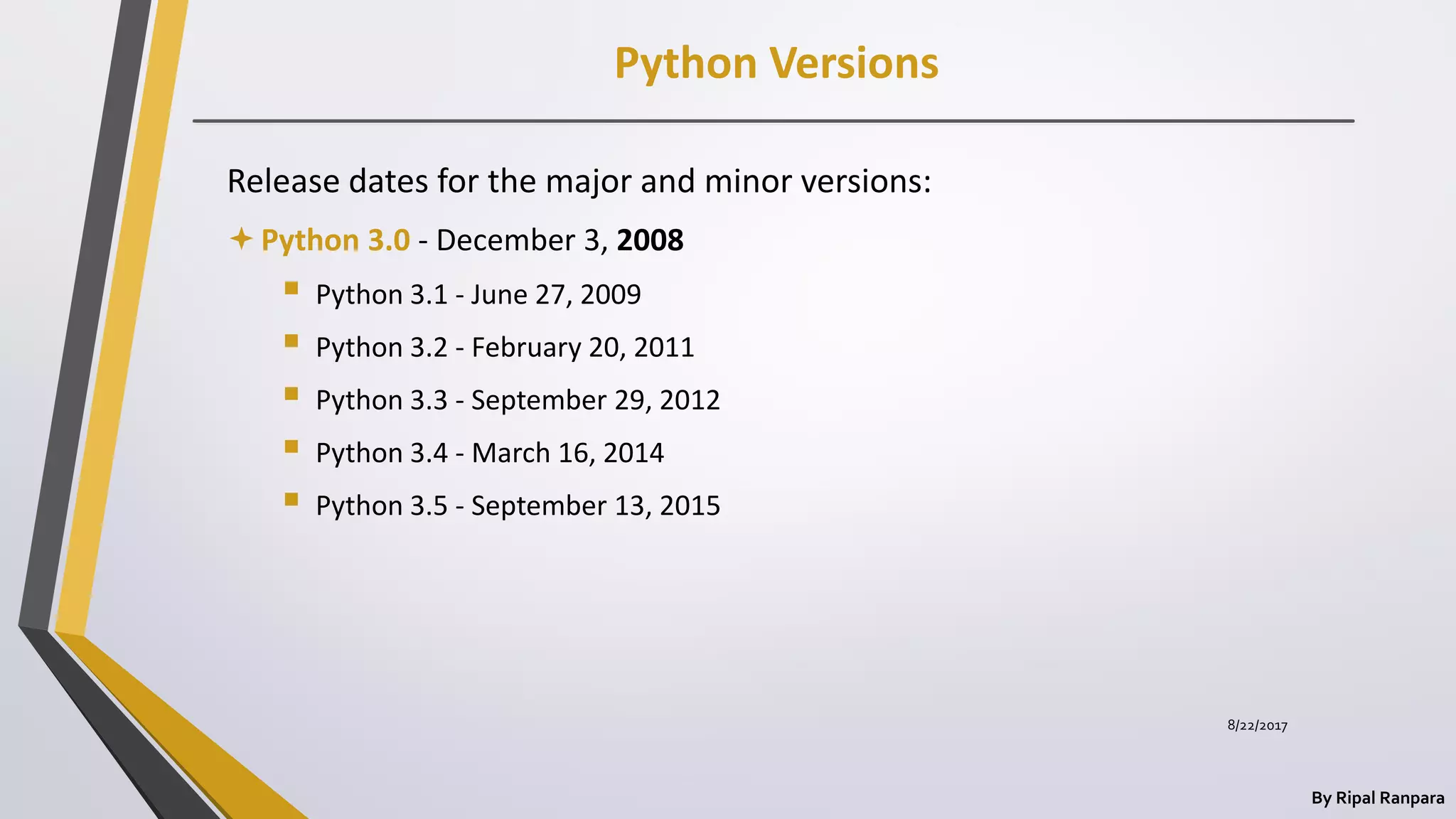
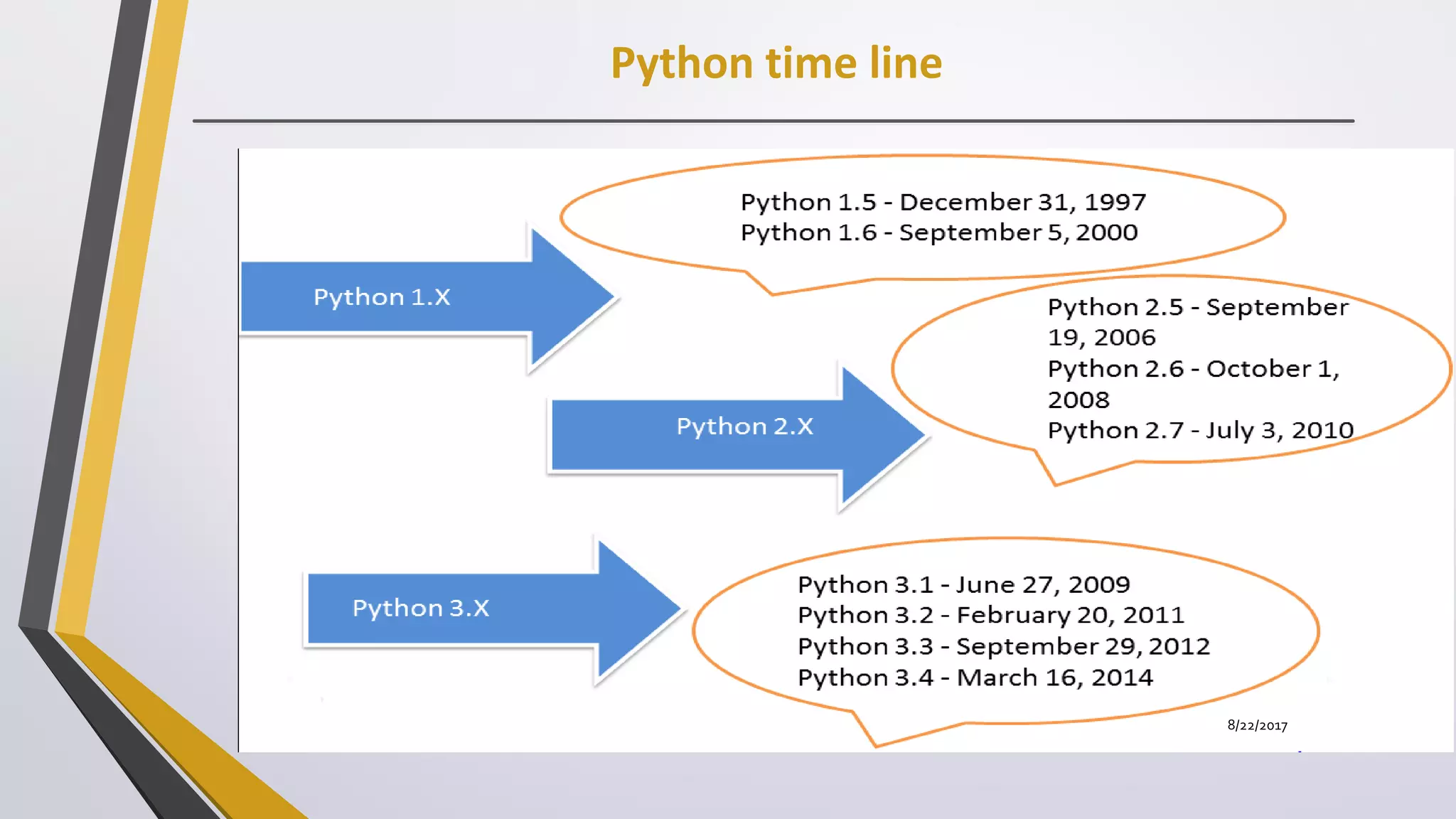
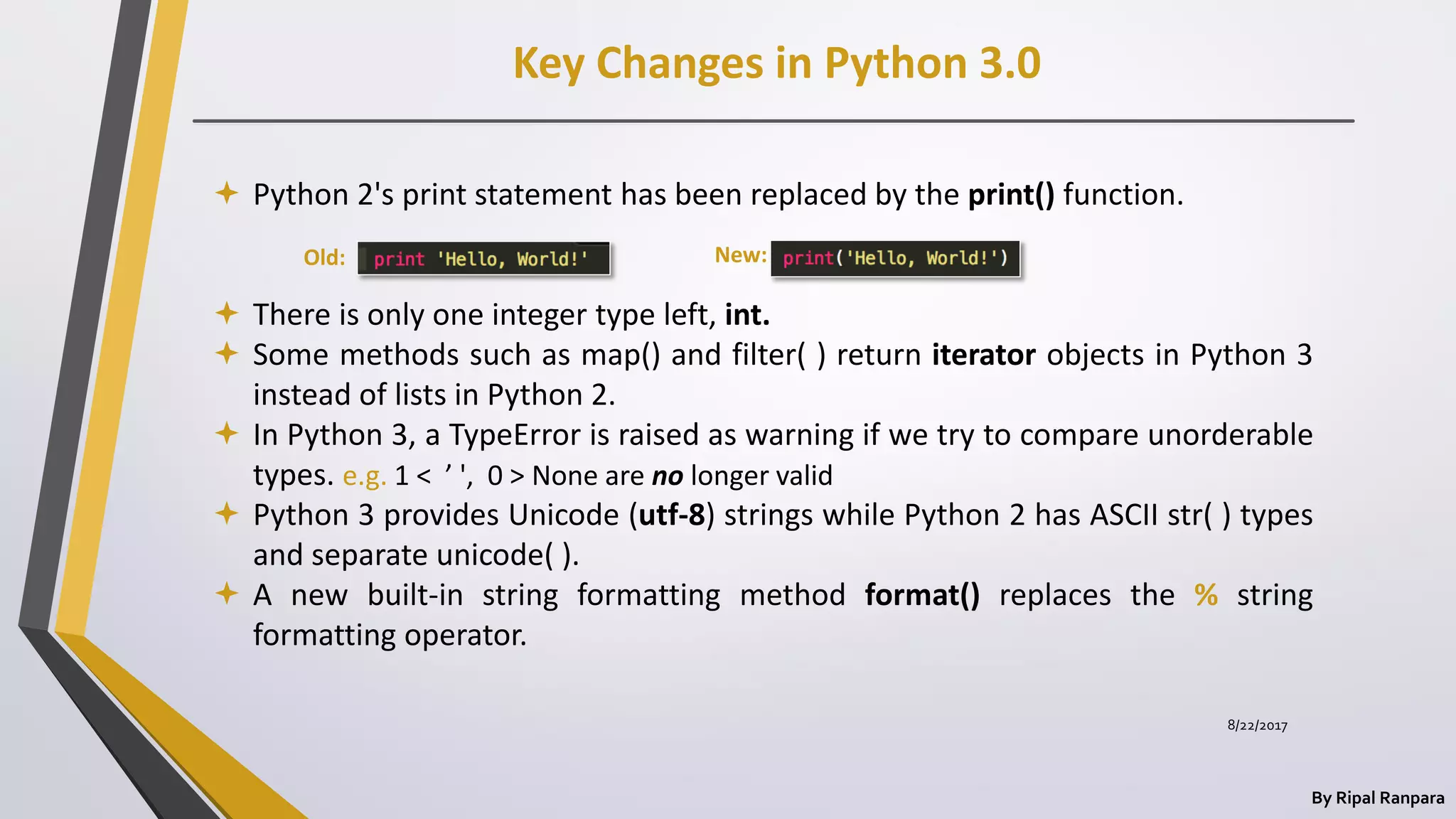
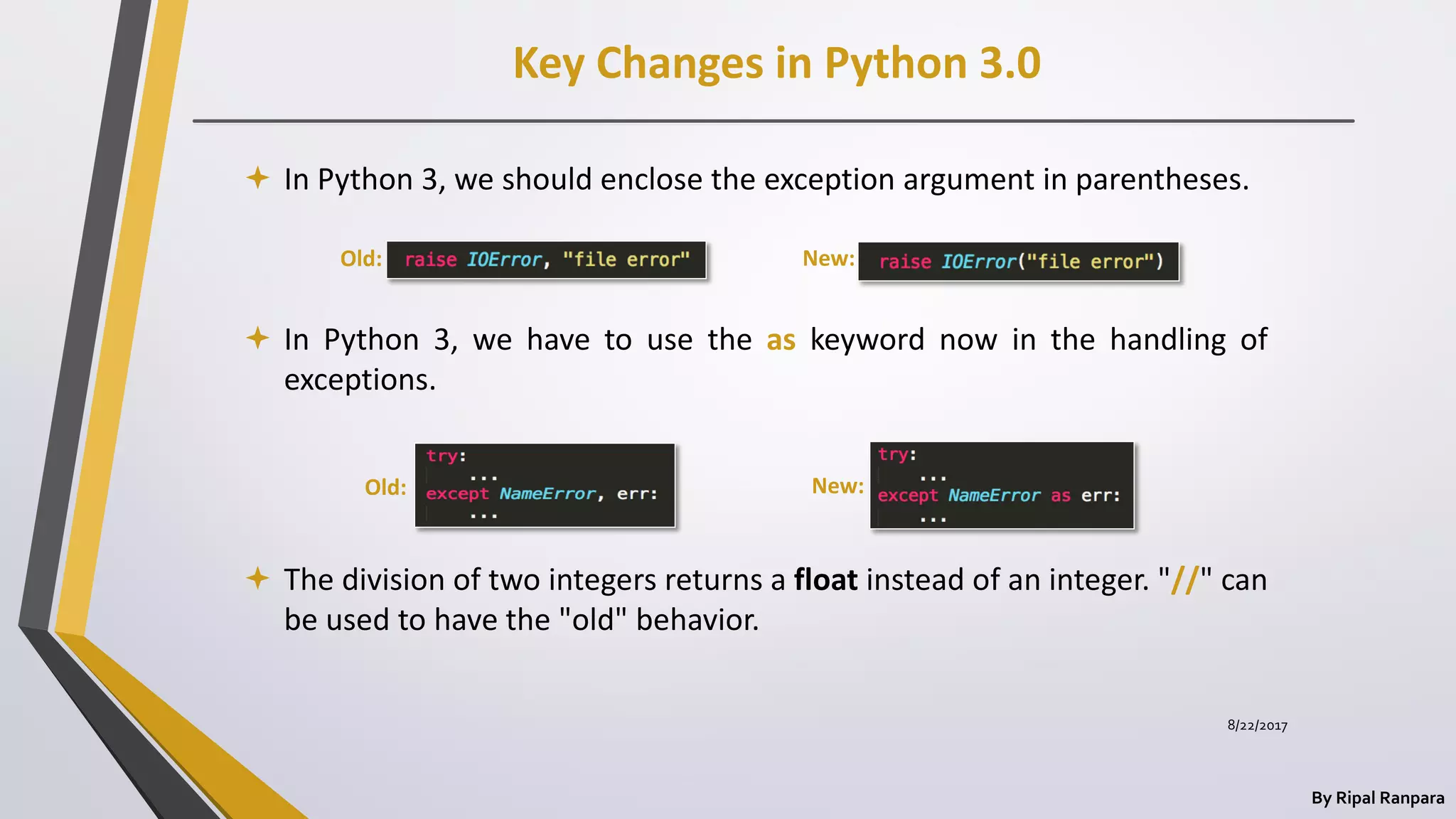

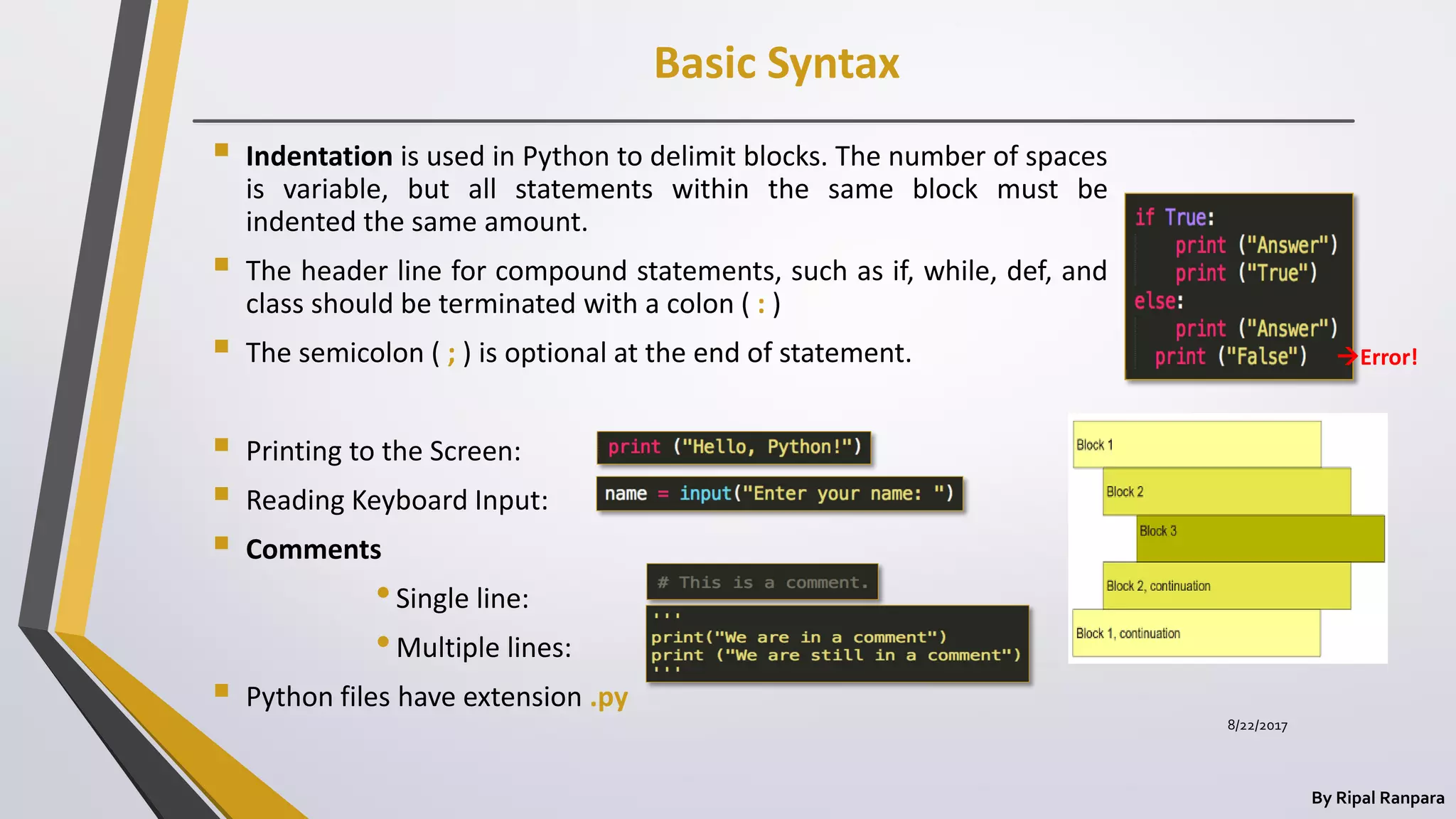
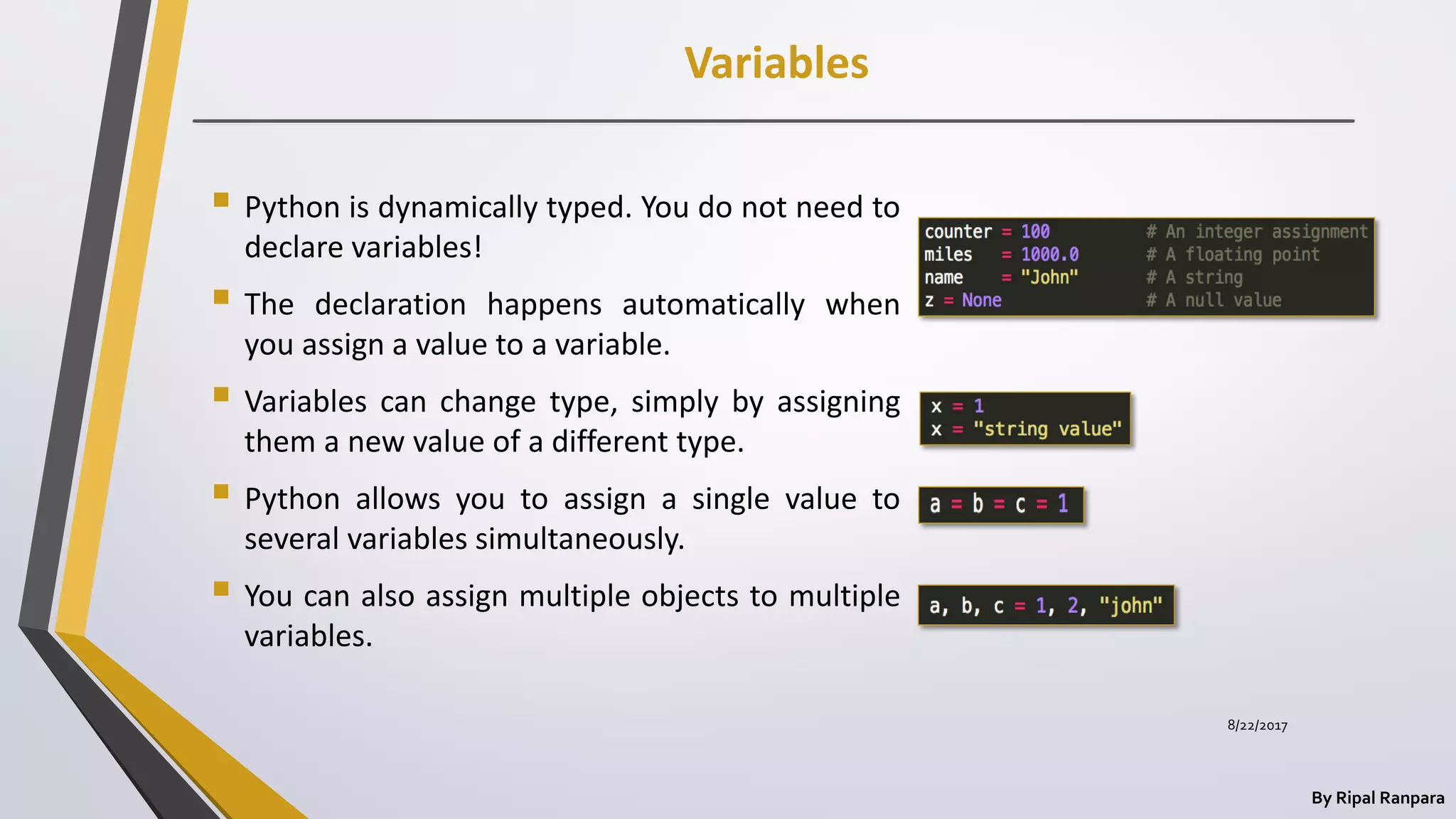
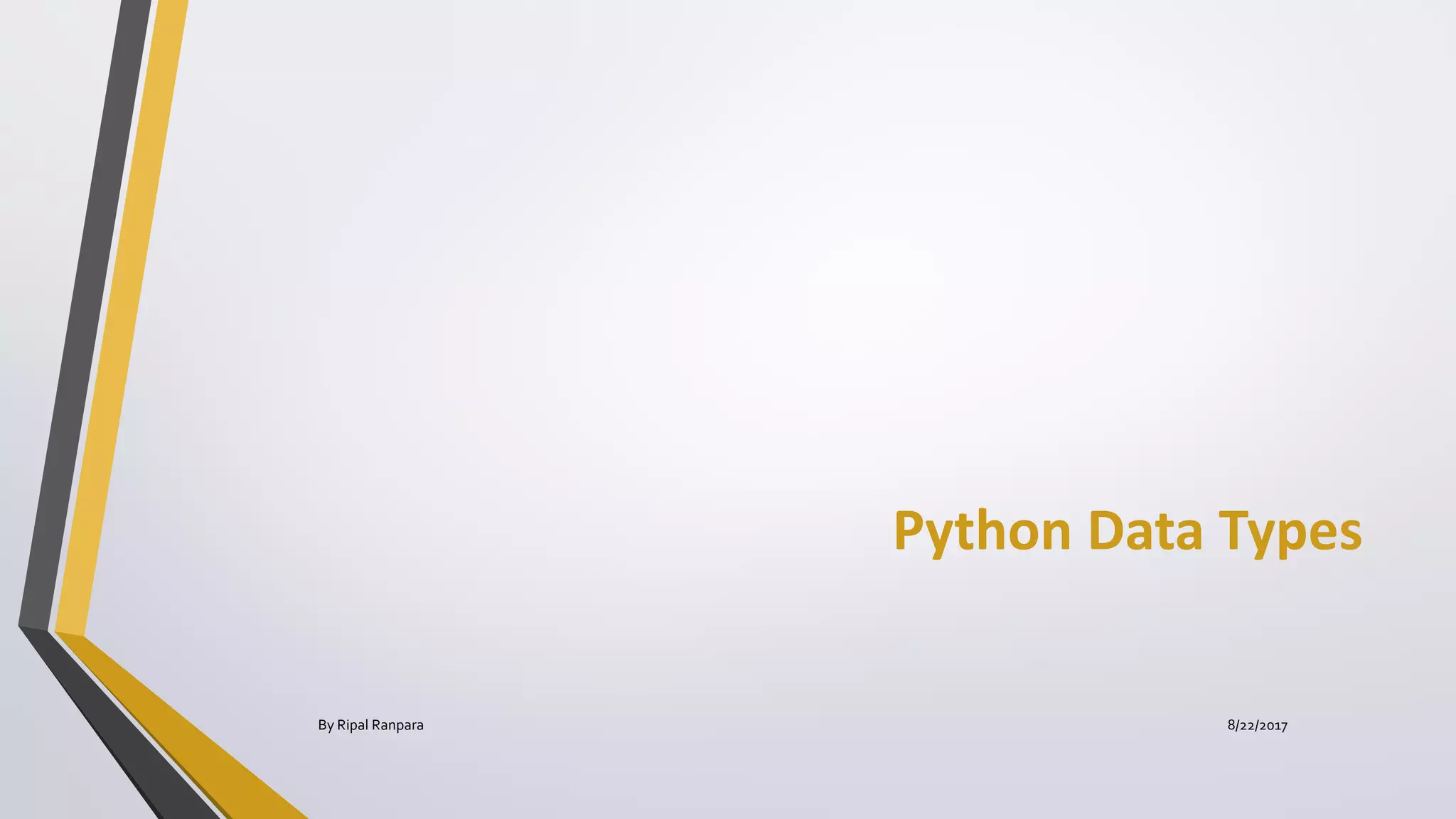
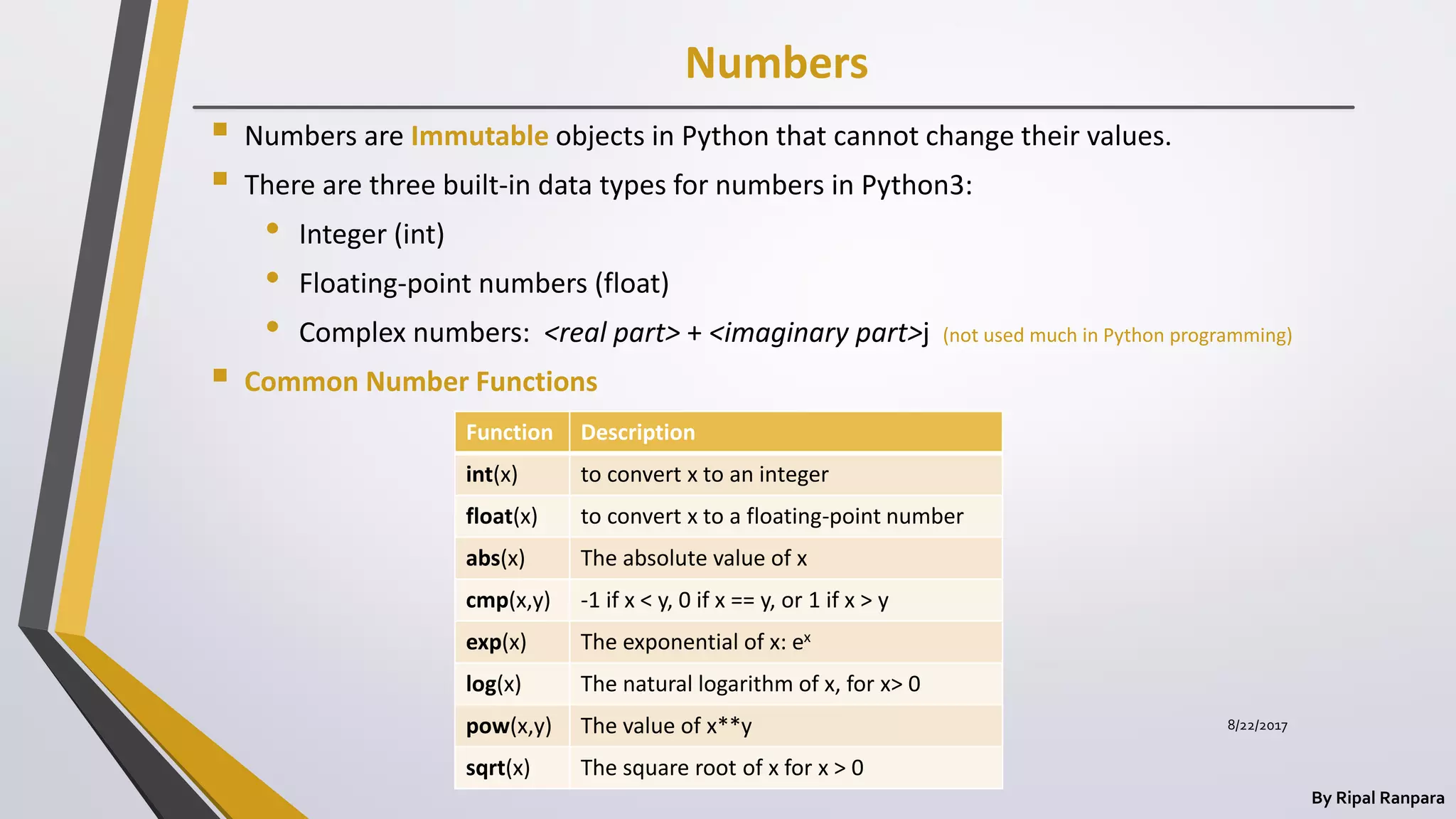
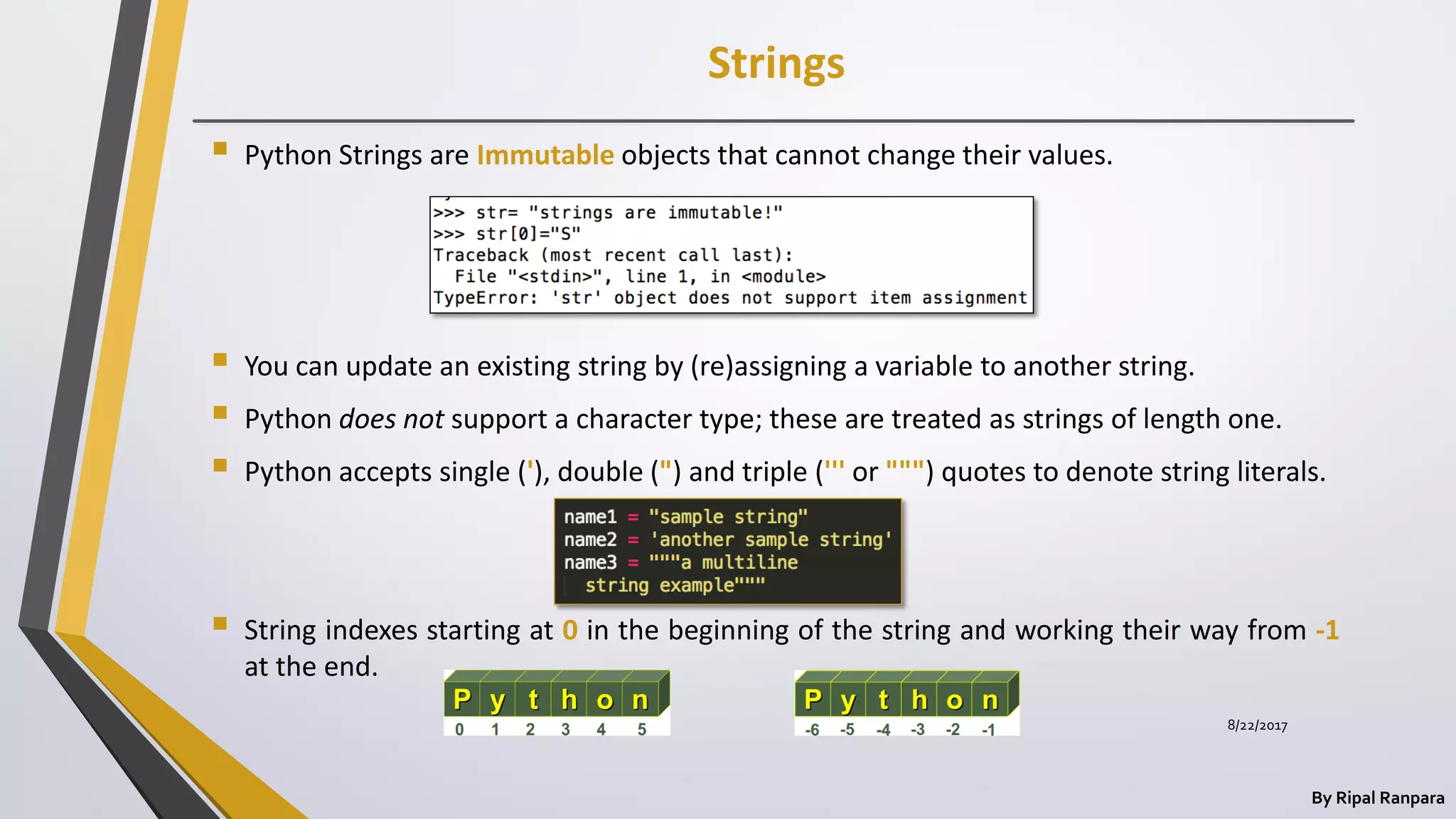
![Strings
By Ripal Ranpara
String Formatting
Common String Operators
Assume string variable a holds 'Hello' and variable b holds 'Python’
Operator Description Example
+ Concatenation - Adds values on either side of the operator a + b will give HelloPython
* Repetition - Creates new strings, concatenating multiple copies of
the same string
a*2 will give HelloHello
[ ] Slice - Gives the character from the given index a[1] will give e
a[-1] will give o
[ : ] Range Slice - Gives the characters from the given range a[1:4] will give ell
in Membership - Returns true if a character exists in the given string ‘H’ in a will give True
8/22/2017](https://image.slidesharecdn.com/pythonfinalppt-170822121204-191113054811/75/Pythonfinalppt-170822121204-26-2048.jpg)
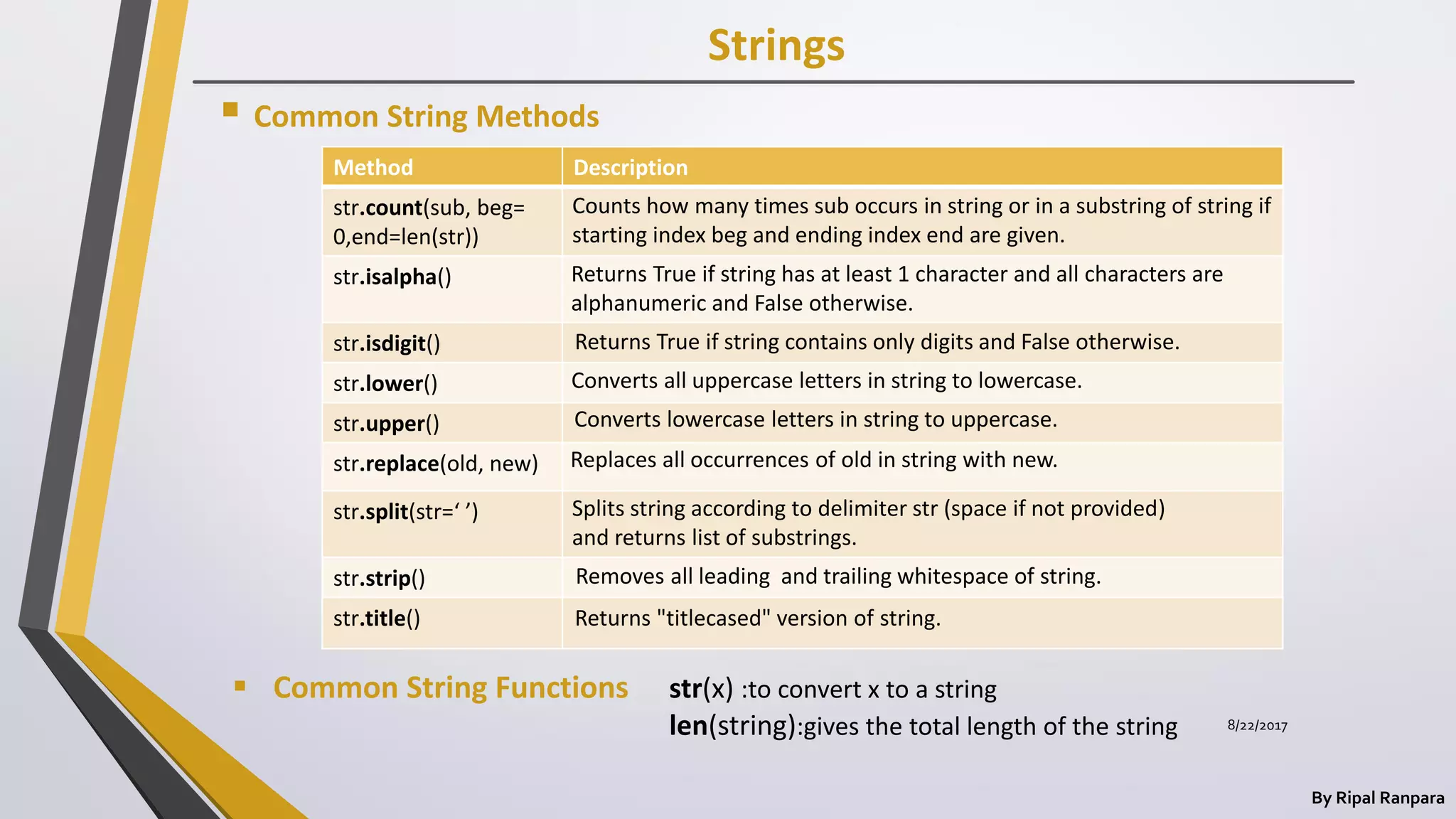
![Lists
By Ripal Ranpara
A list in Python is an ordered group of items or elements, and these list elements don't
have to be of the same type.
Python Lists are mutable objects that can change their values.
A list contains items separated by commas and enclosed within square brackets.
List indexes like strings starting at 0 in the beginning of the list and working their way
from -1 at the end.
Similar to strings, Lists operations include slicing ([ ] and [:]) , concatenation (+),
repetition (*), and membership (in).
This example shows how to access, update and delete list elements:
access
slice
update
delete
8/22/2017](https://image.slidesharecdn.com/pythonfinalppt-170822121204-191113054811/75/Pythonfinalppt-170822121204-28-2048.jpg)

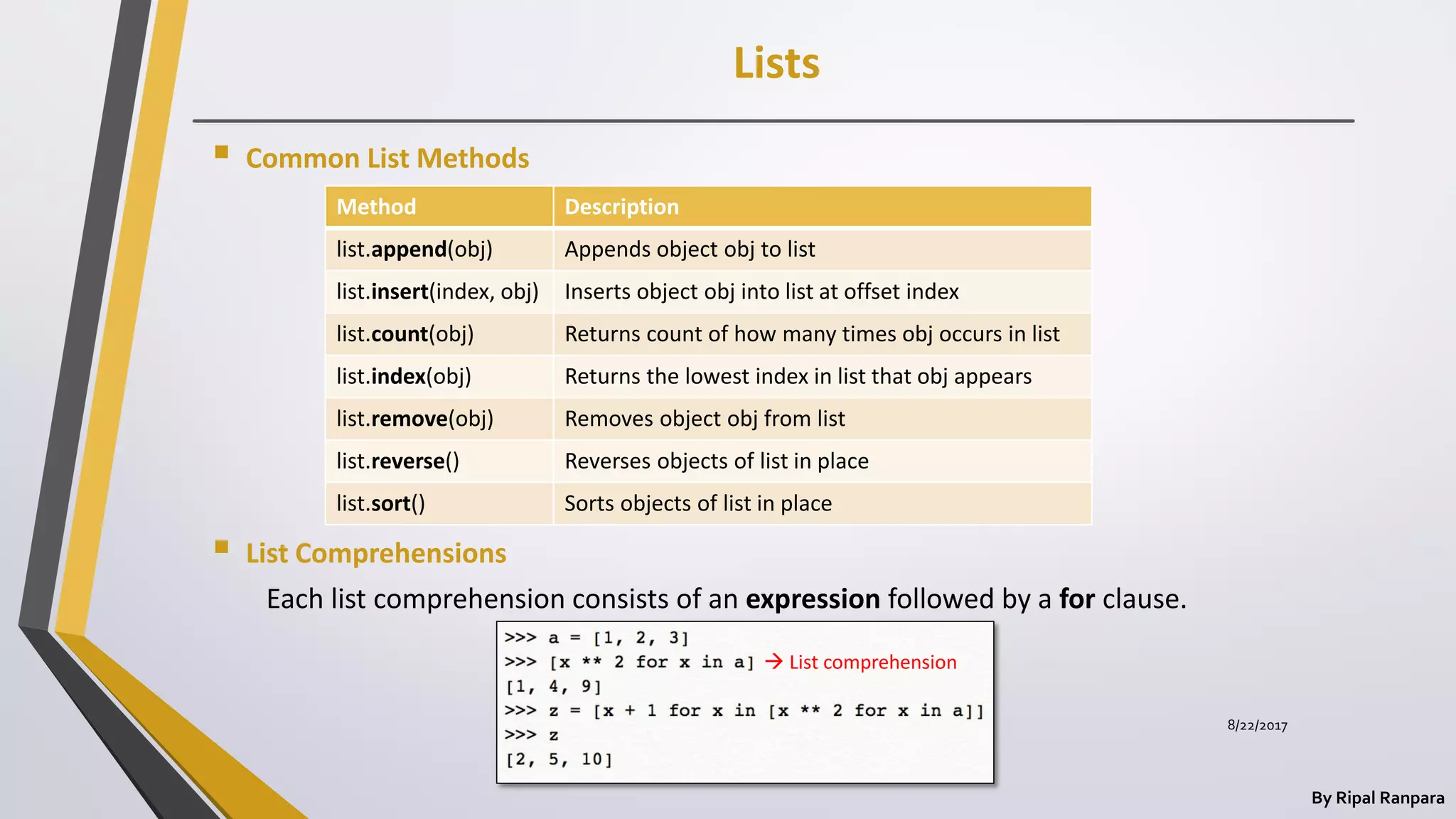
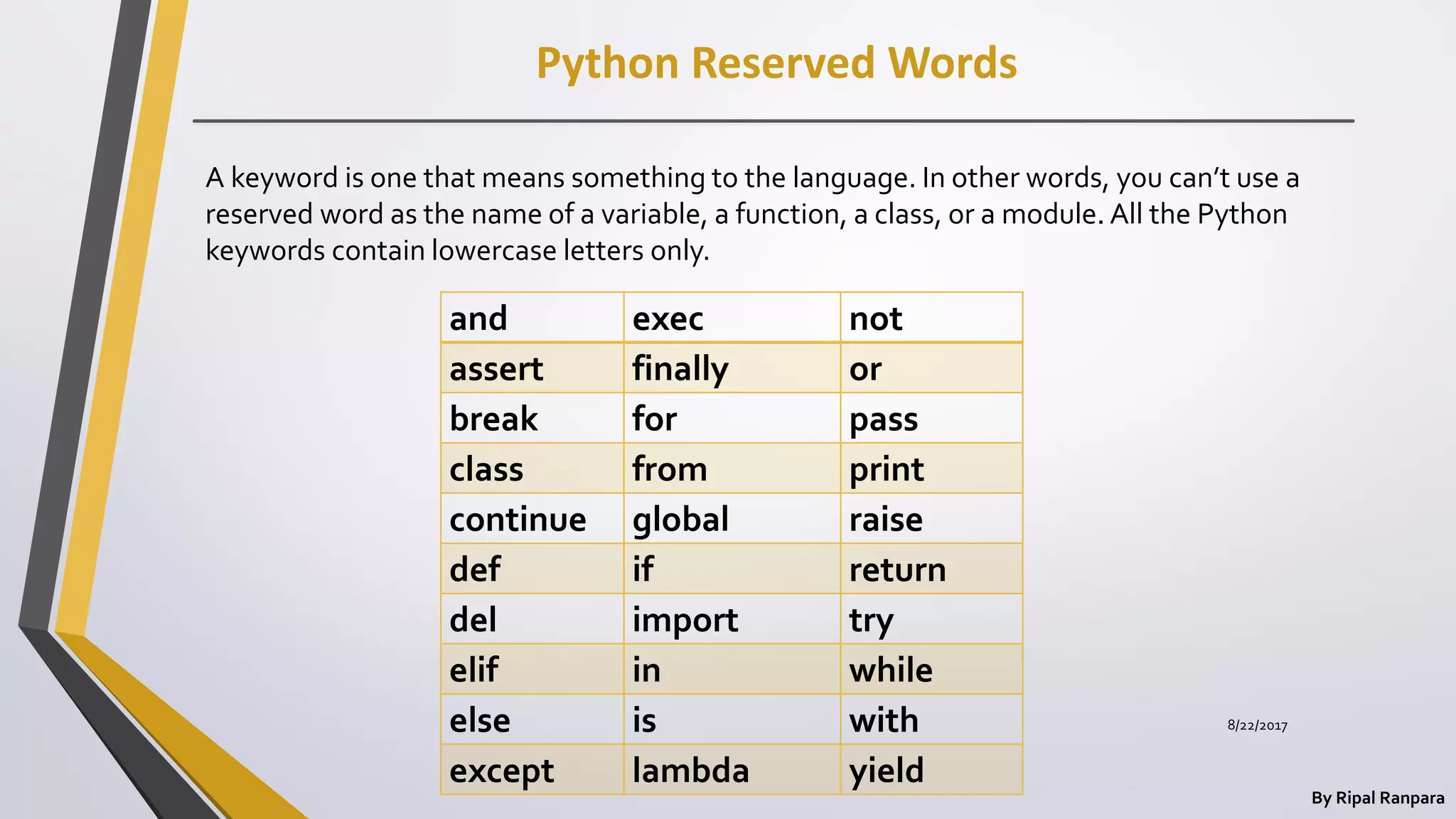
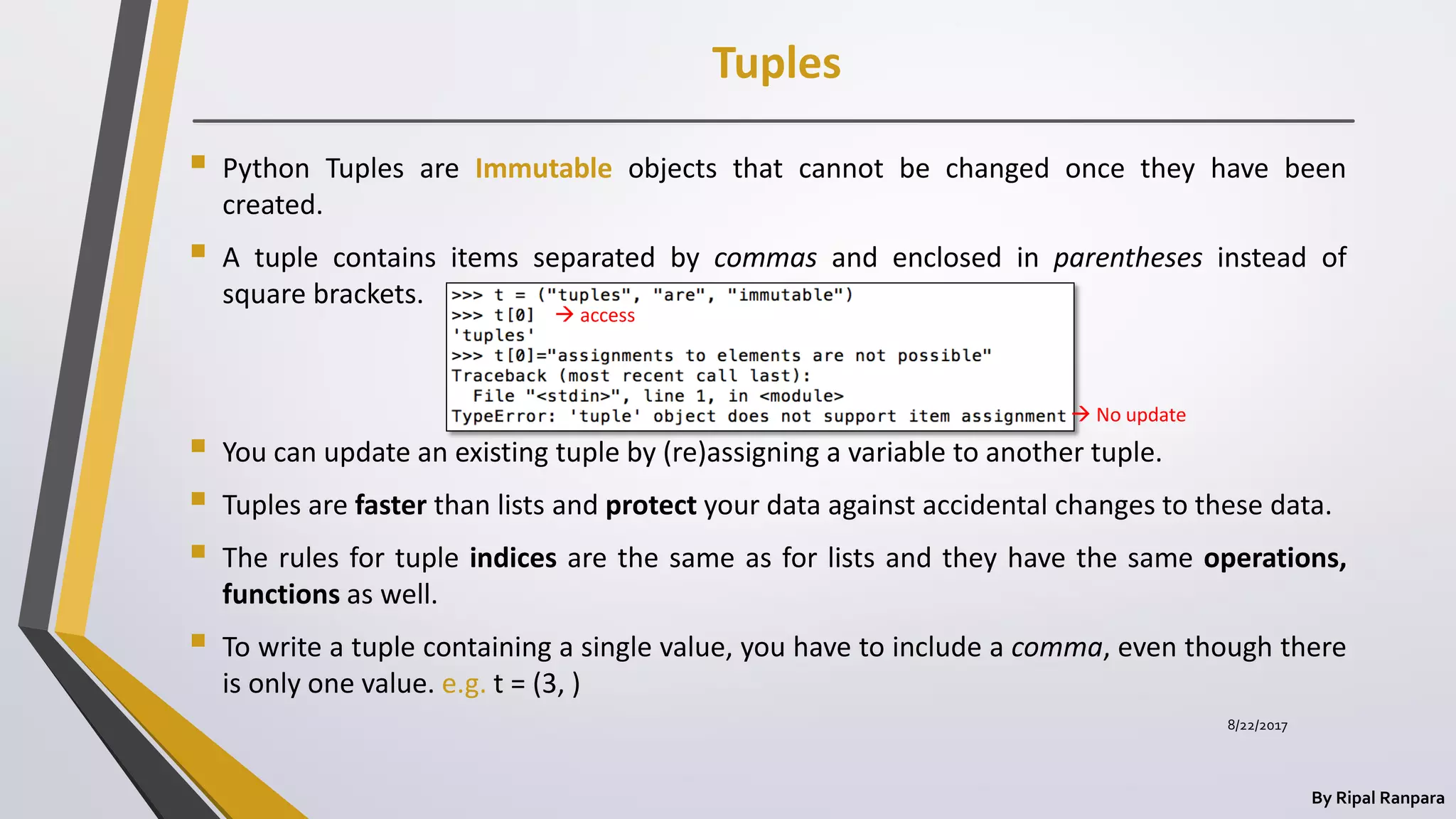
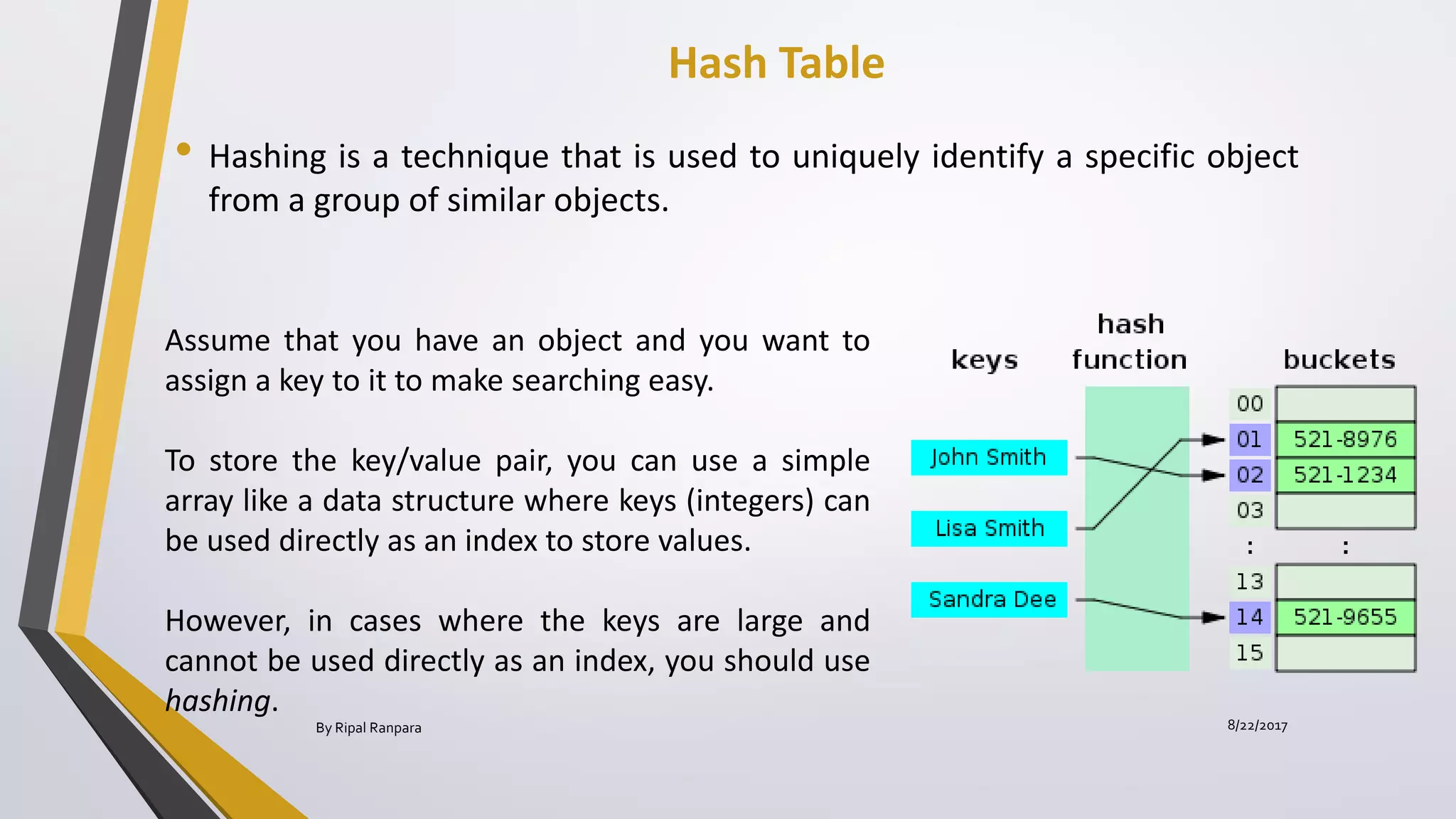
![Dictionary
By Ripal Ranpara
Python's dictionaries are kind of hash table type which consist of key-value pairs
of unordered elements.
• Keys : must be immutable data types ,usually numbers or strings.
• Values : can be any arbitrary Python object.
Python Dictionaries are mutable objects that can change their values.
A dictionary is enclosed by curly braces ({ }), the items are separated by commas,
and each key is separated from its value by a colon (:).
Dictionary’s values can be assigned and accessed using square braces ([]) with a
key to obtain its value.
8/22/2017](https://image.slidesharecdn.com/pythonfinalppt-170822121204-191113054811/75/Pythonfinalppt-170822121204-34-2048.jpg)

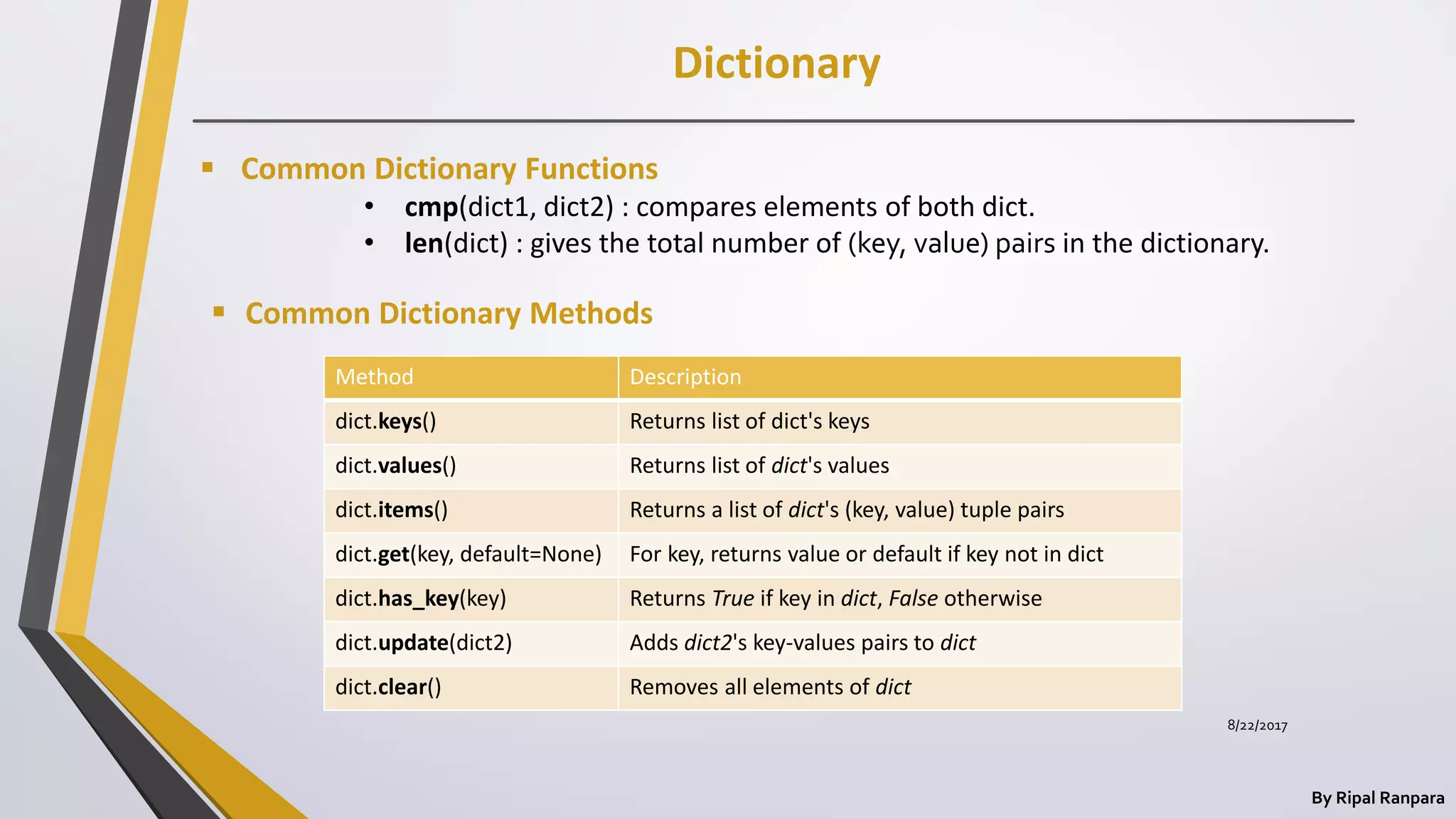
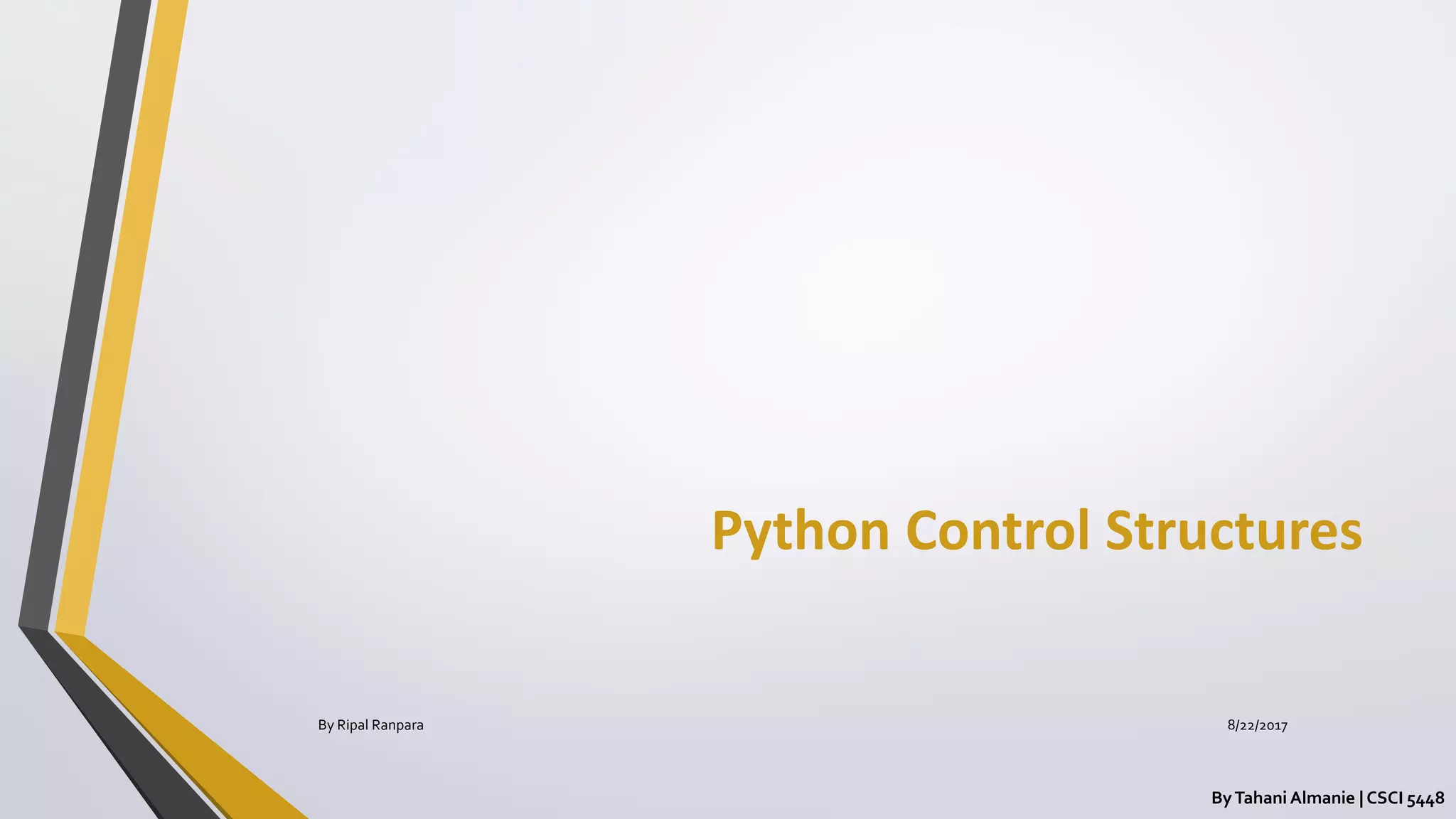
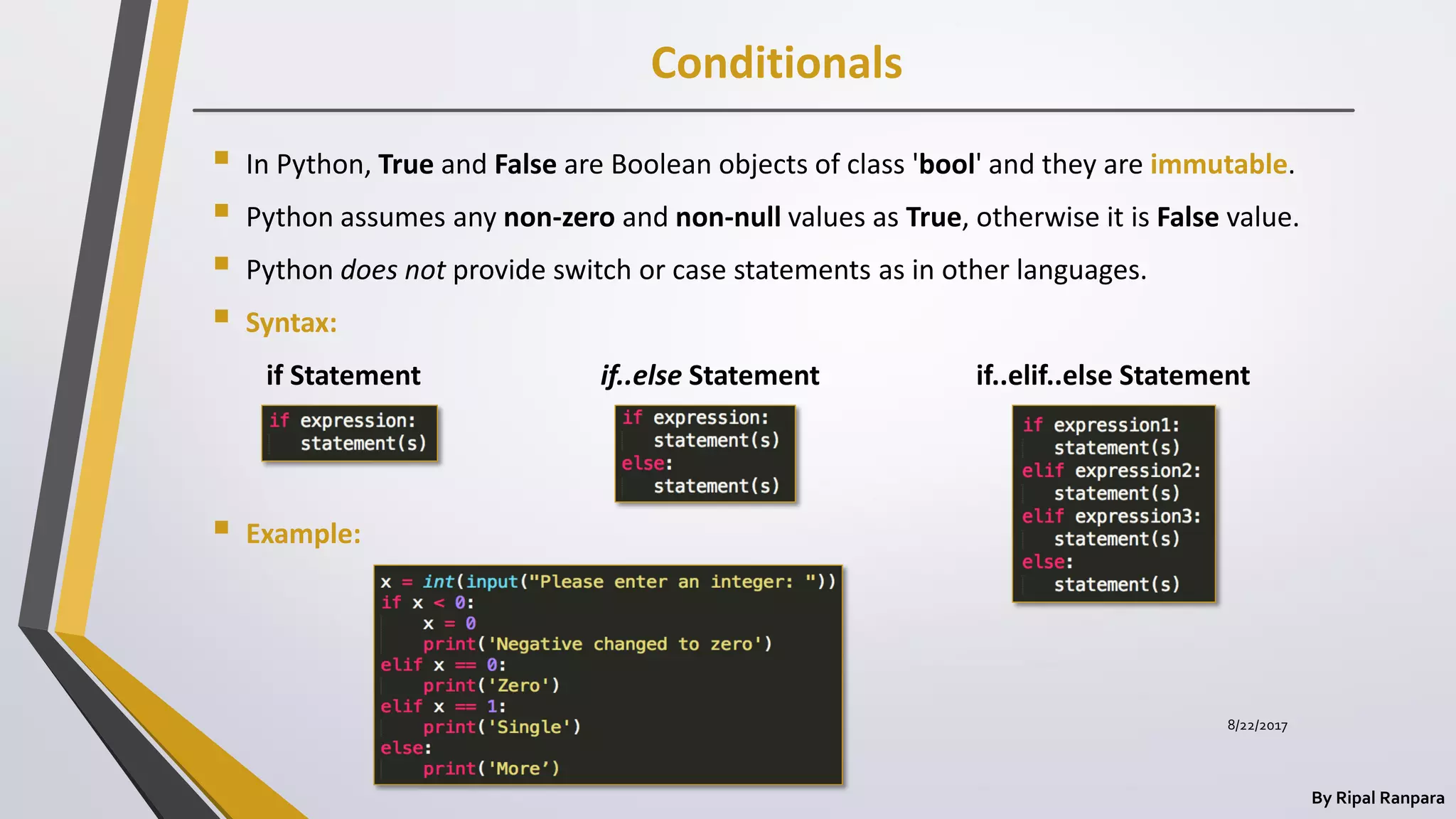
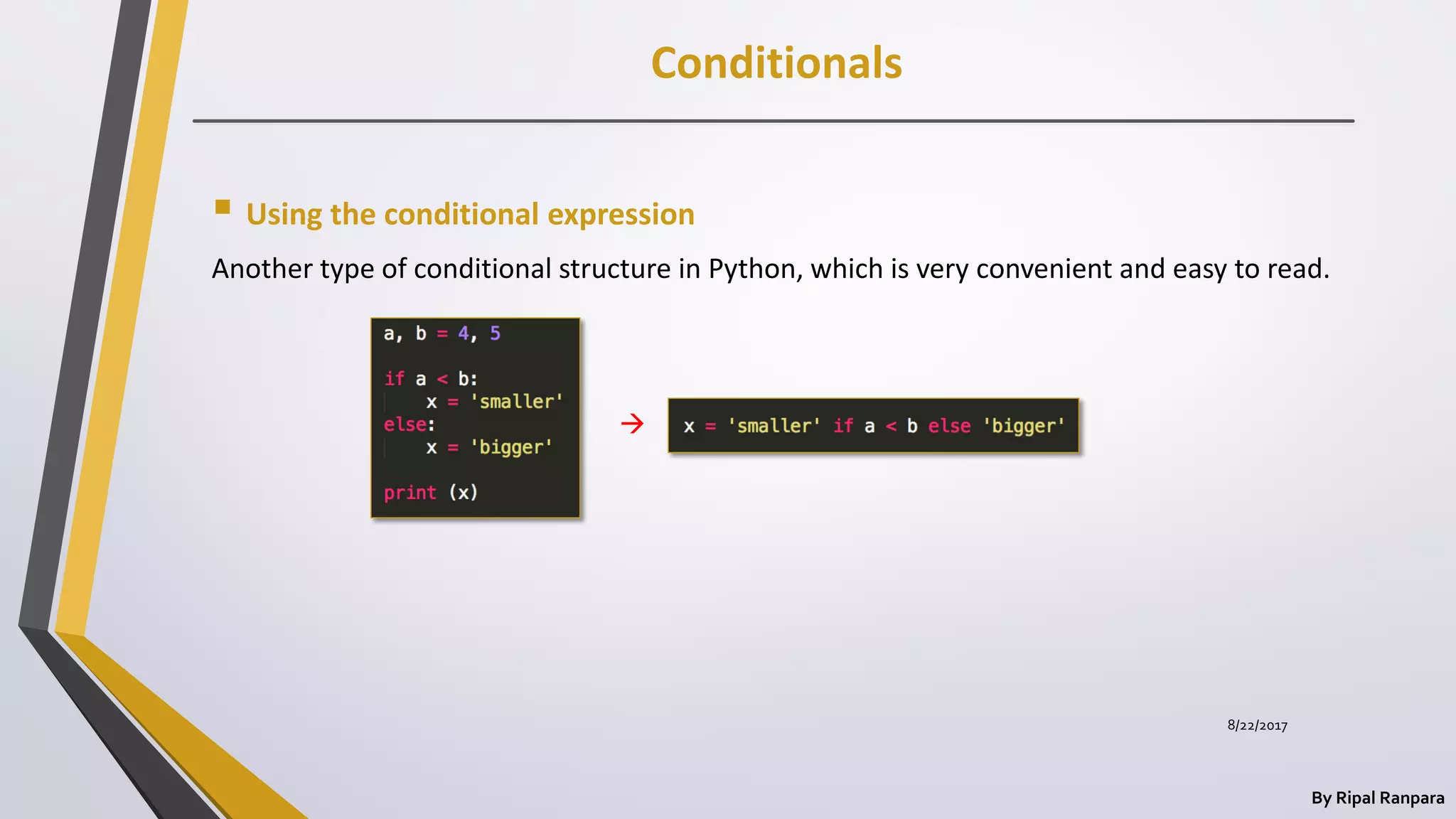
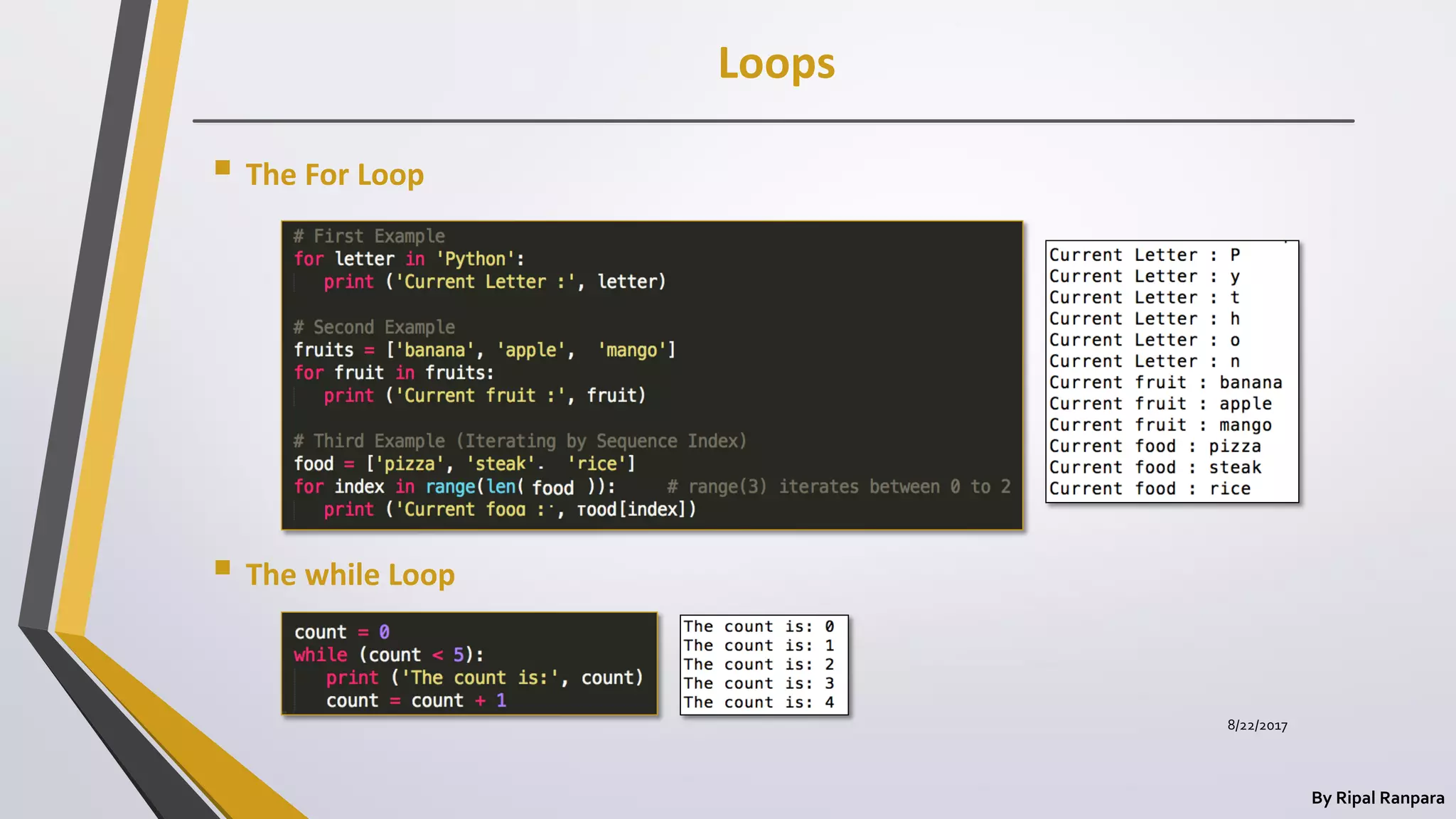
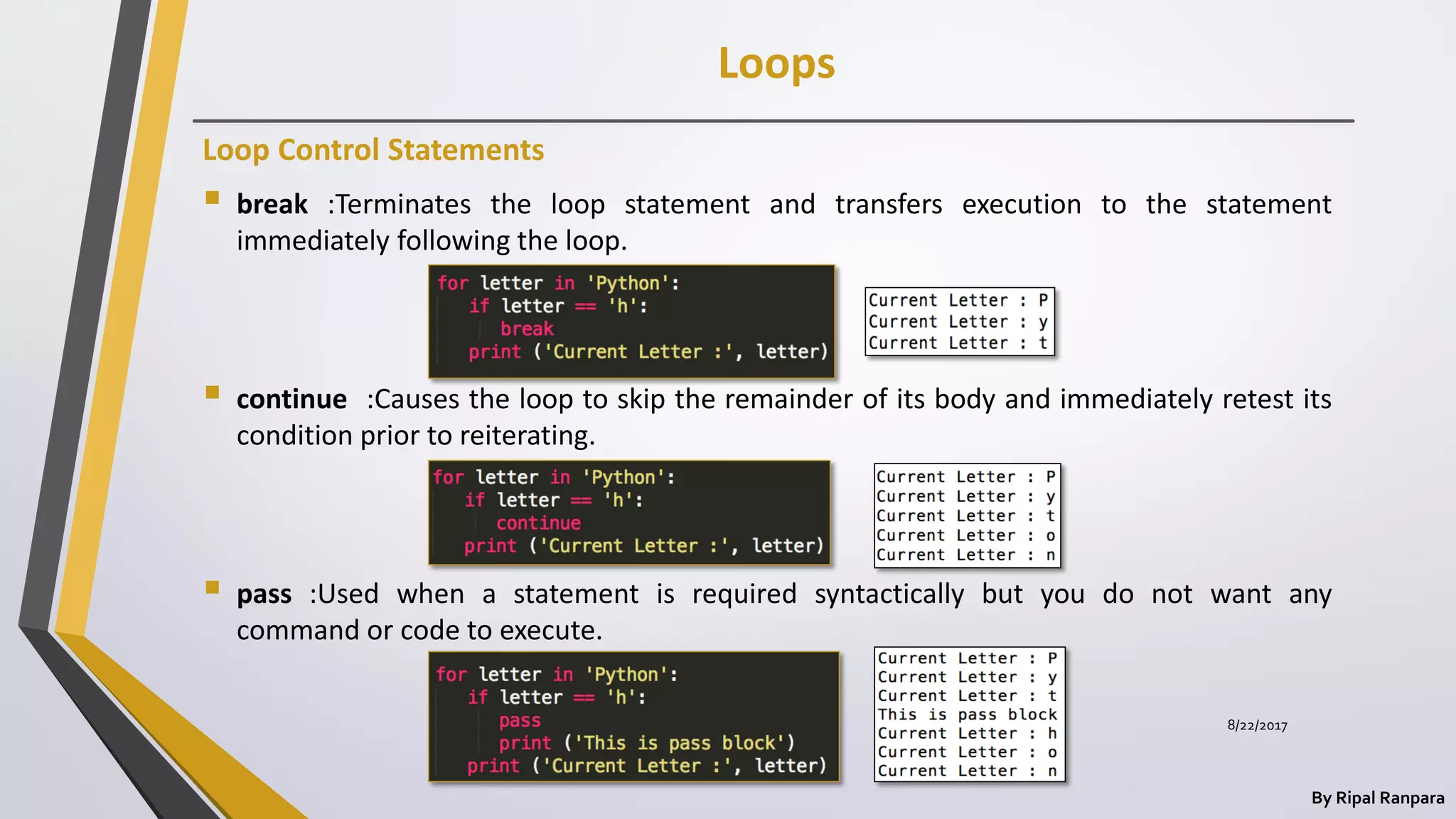
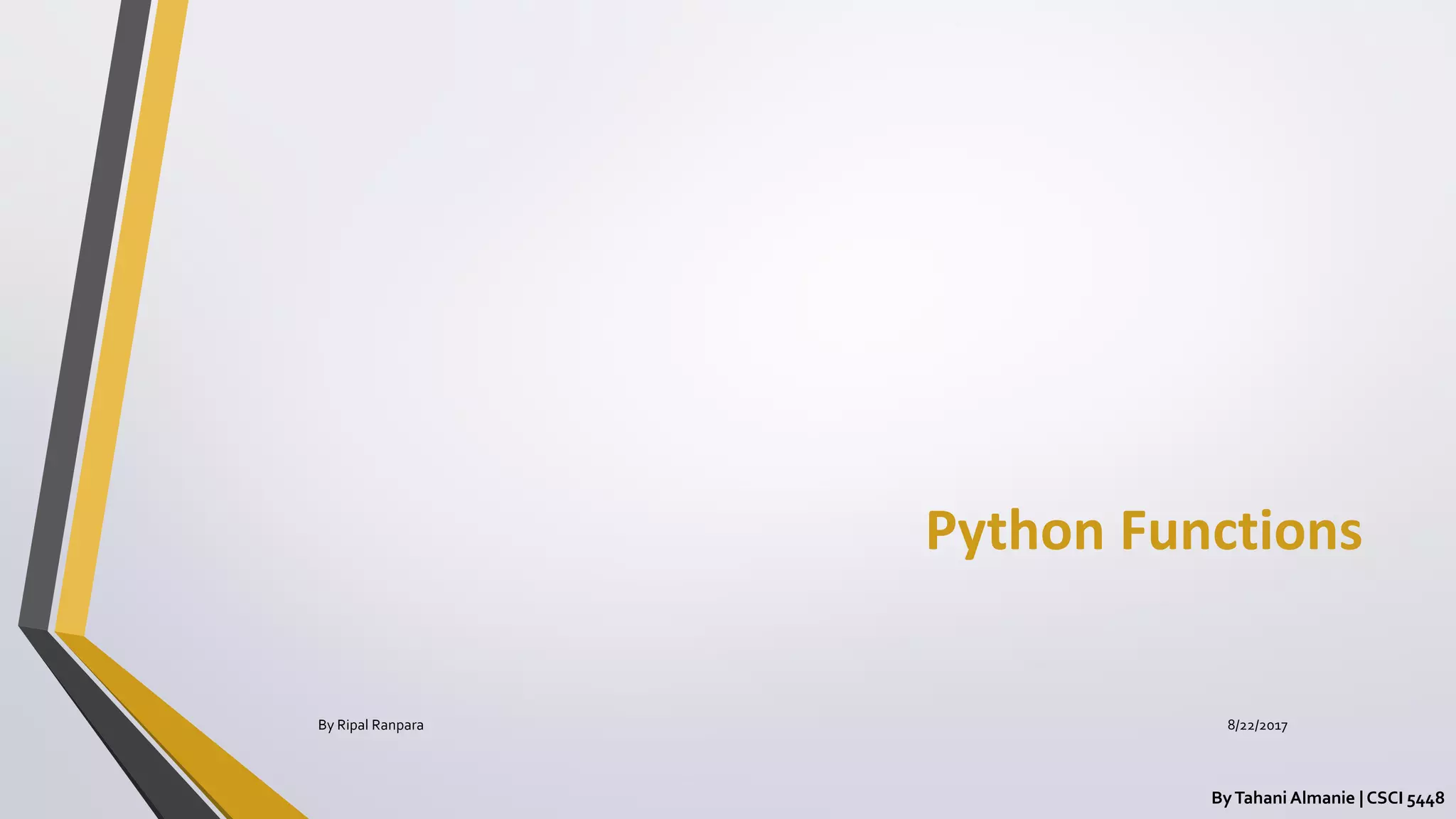
![Functions
By Ripal Ranpara
8/22/2017
A function is a block of organized, reusable code that is used to perform a single, related action.
Functions provide better modularity for your application and a high degree of code reusing.
Defining a Function
• Function blocks begin with the keyword def followed by the function name and parentheses (
( ) ).
• Any input parameters or arguments should be placed within these parentheses. You can also
define parameters inside these parentheses.
• The first statement of a function can be an optional statement - the documentation string of
the function or docstring.
• The code block within every function starts with a colon (:) and is indented.
• The statement return [expression] exits a function, optionally passing back an expression to
the caller. A return statement with no arguments is the same as return None.](https://image.slidesharecdn.com/pythonfinalppt-170822121204-191113054811/75/Pythonfinalppt-170822121204-43-2048.jpg)
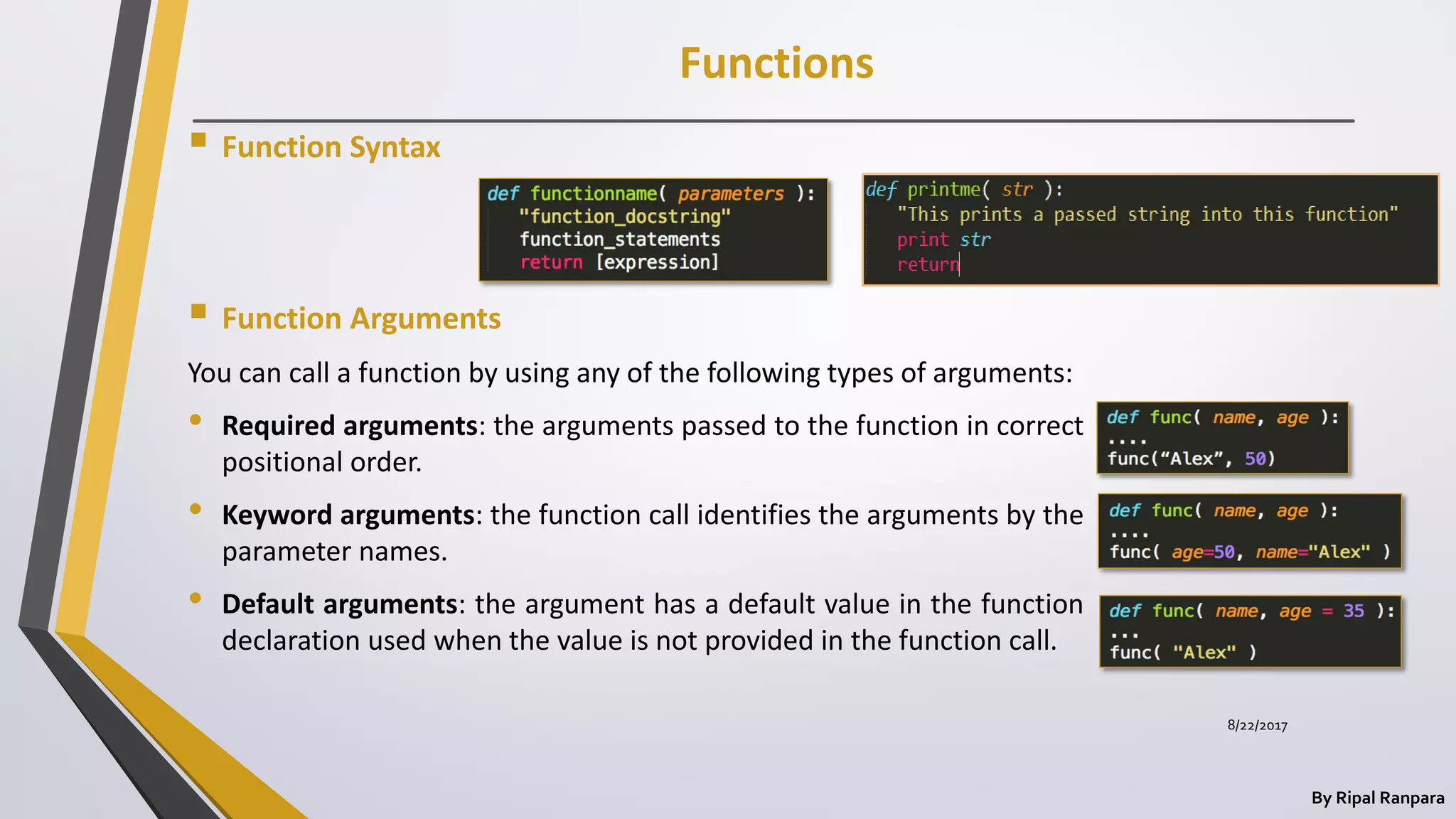
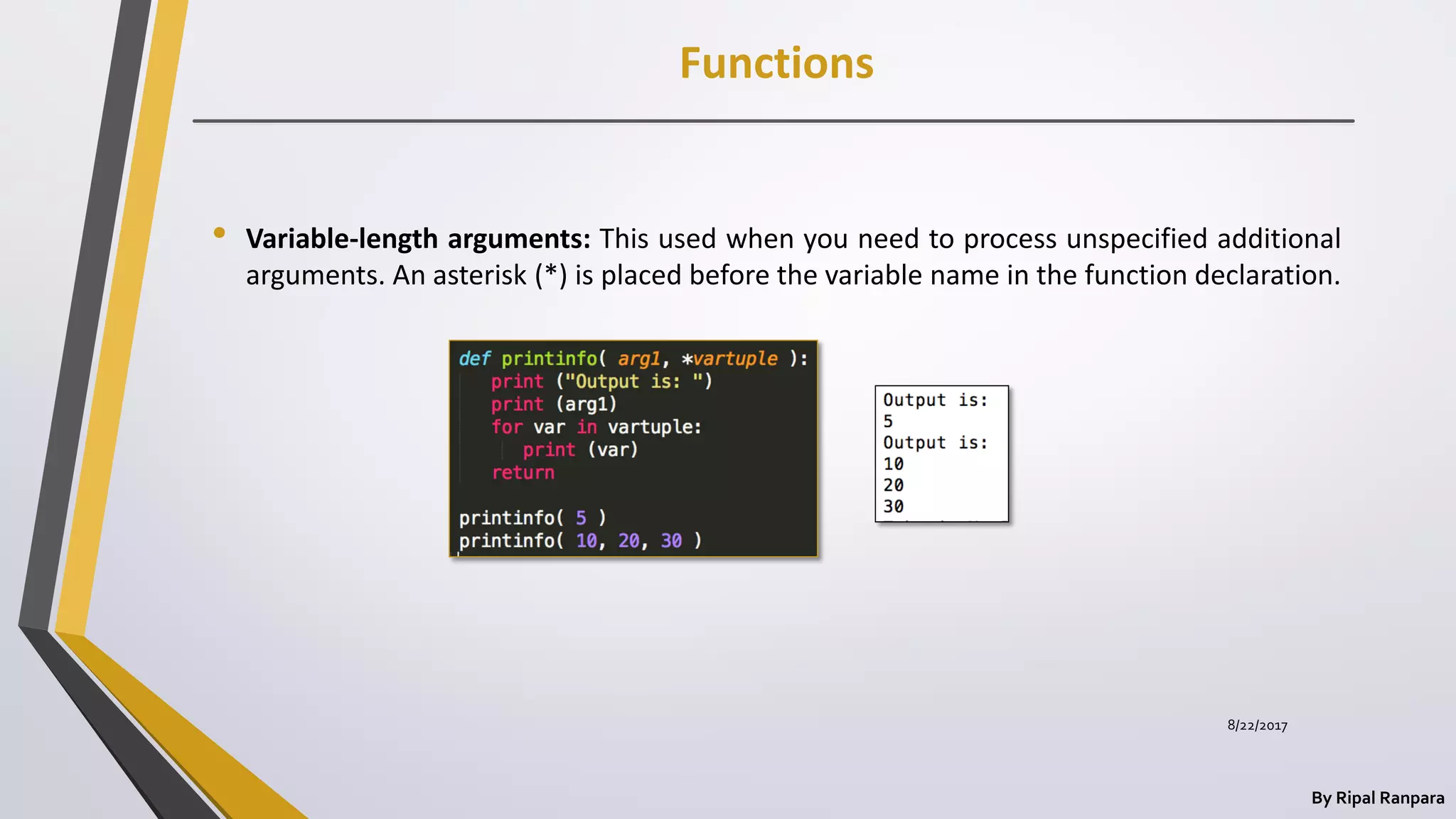

![File Handling
By Ripal Ranpara
File opening fileObject = open(file_name [, access_mode][, buffering])
Common access modes:
• “r” opens a file for reading only.
• “w” opens a file for writing only. Overwrites the file if the file exists.
Otherwise, it creates a new file.
• “a” opens a file for appending. If the file does not exist, it creates a new file
for writing.
Closing a file fileObject.close()
The close() method flushes any unwritten information and closes the file object.
8/22/2017](https://image.slidesharecdn.com/pythonfinalppt-170822121204-191113054811/75/Pythonfinalppt-170822121204-47-2048.jpg)
![File Handling
By Ripal Ranpara
Reading a file fileObject.read([count])
• The read() method reads the whole file at once.
• The readline() method reads one line each time from the file.
• The readlines() method reads all lines from the file in a list.
Writing in a file fileObject.write(string)
The write() method writes any string to an open file.
8/22/2017](https://image.slidesharecdn.com/pythonfinalppt-170822121204-191113054811/75/Pythonfinalppt-170822121204-48-2048.jpg)
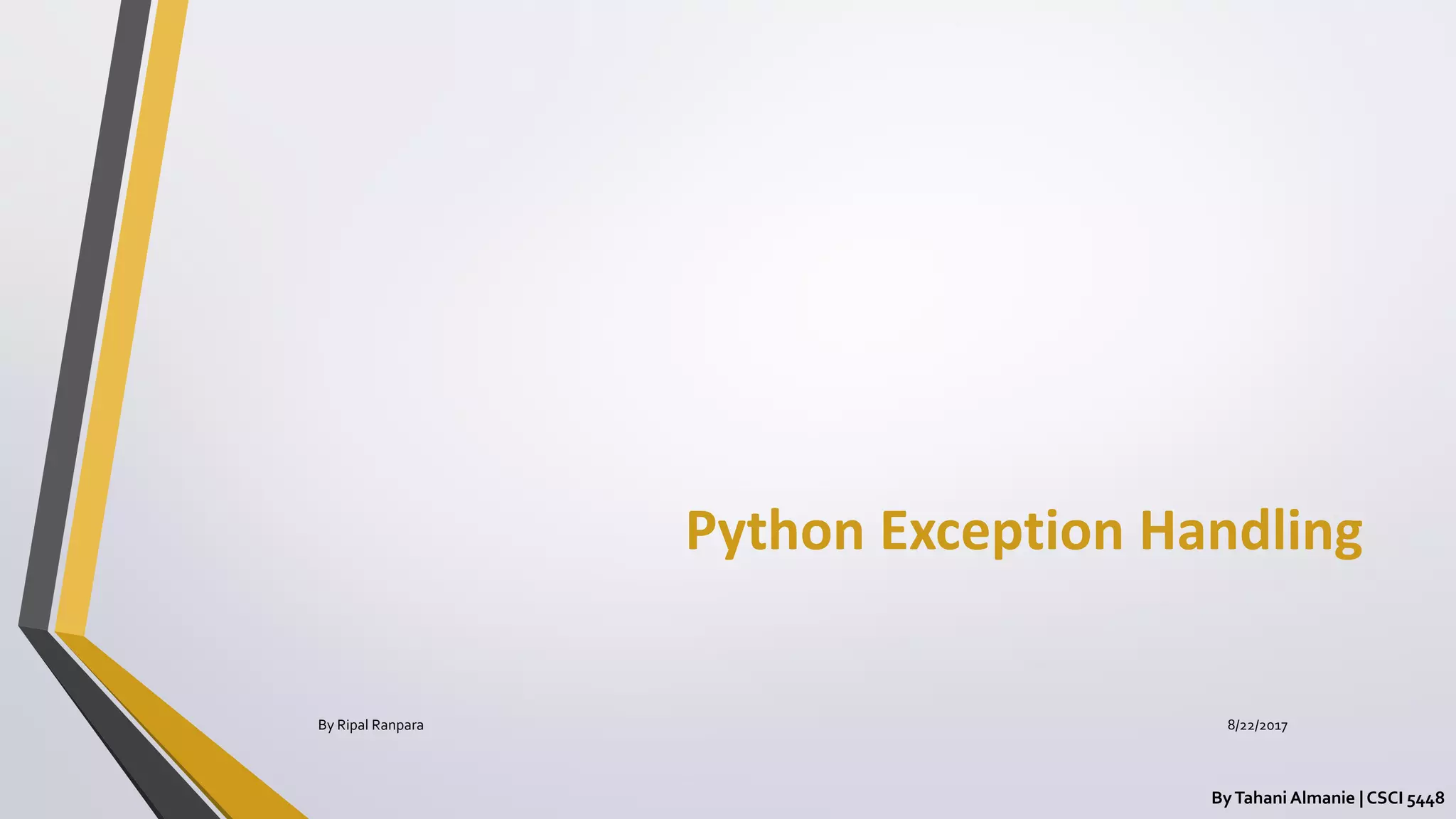
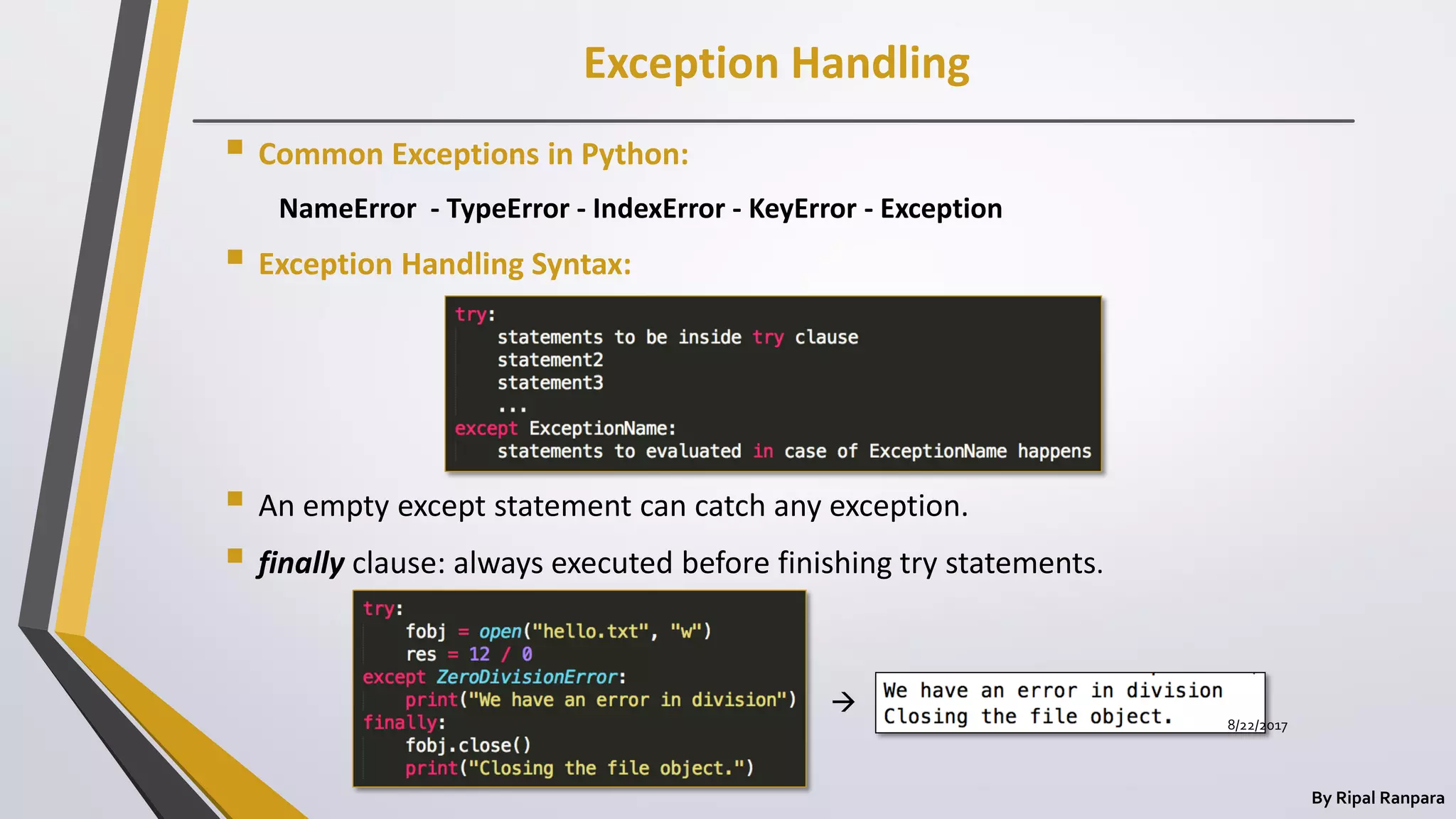
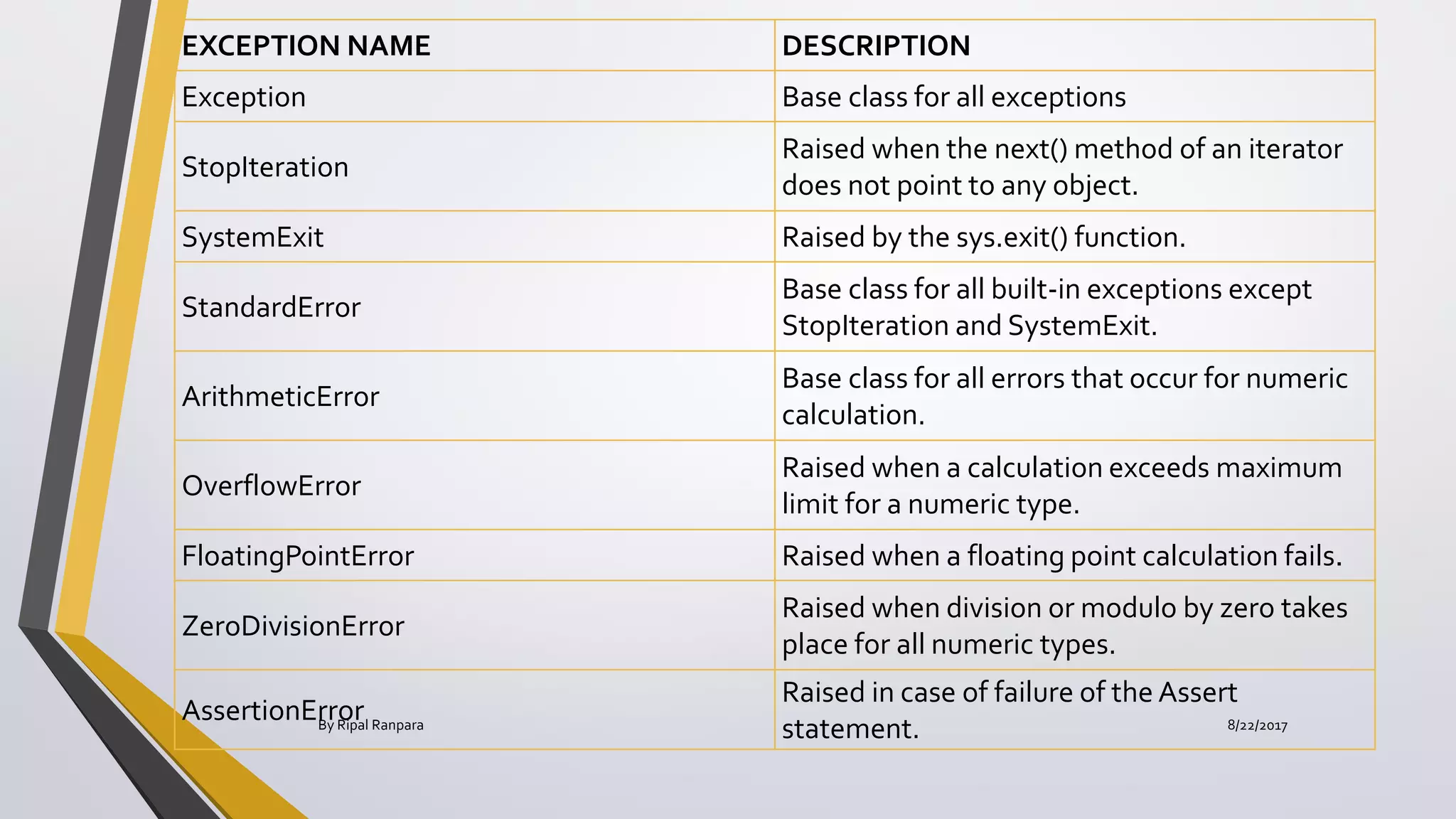

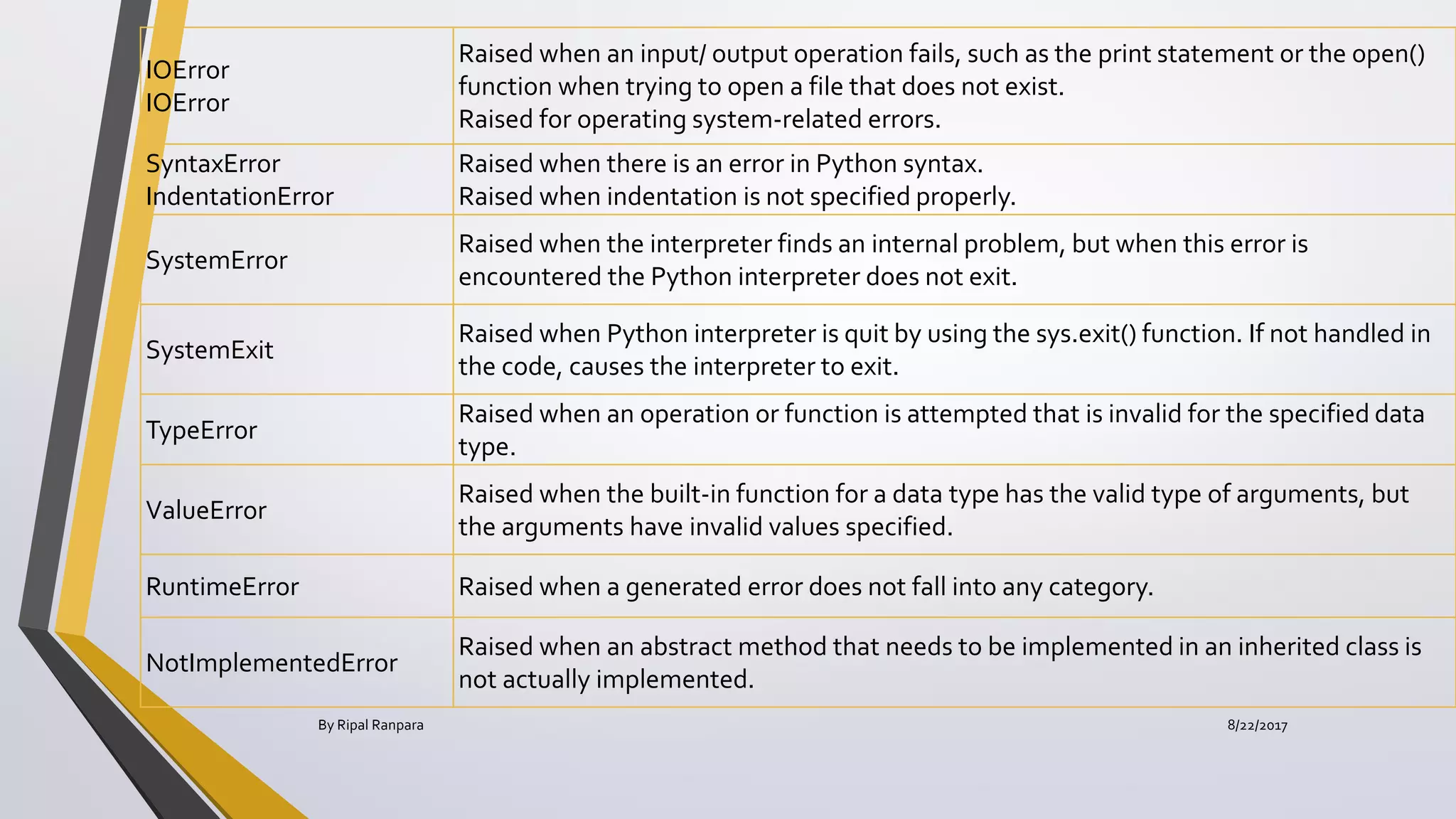
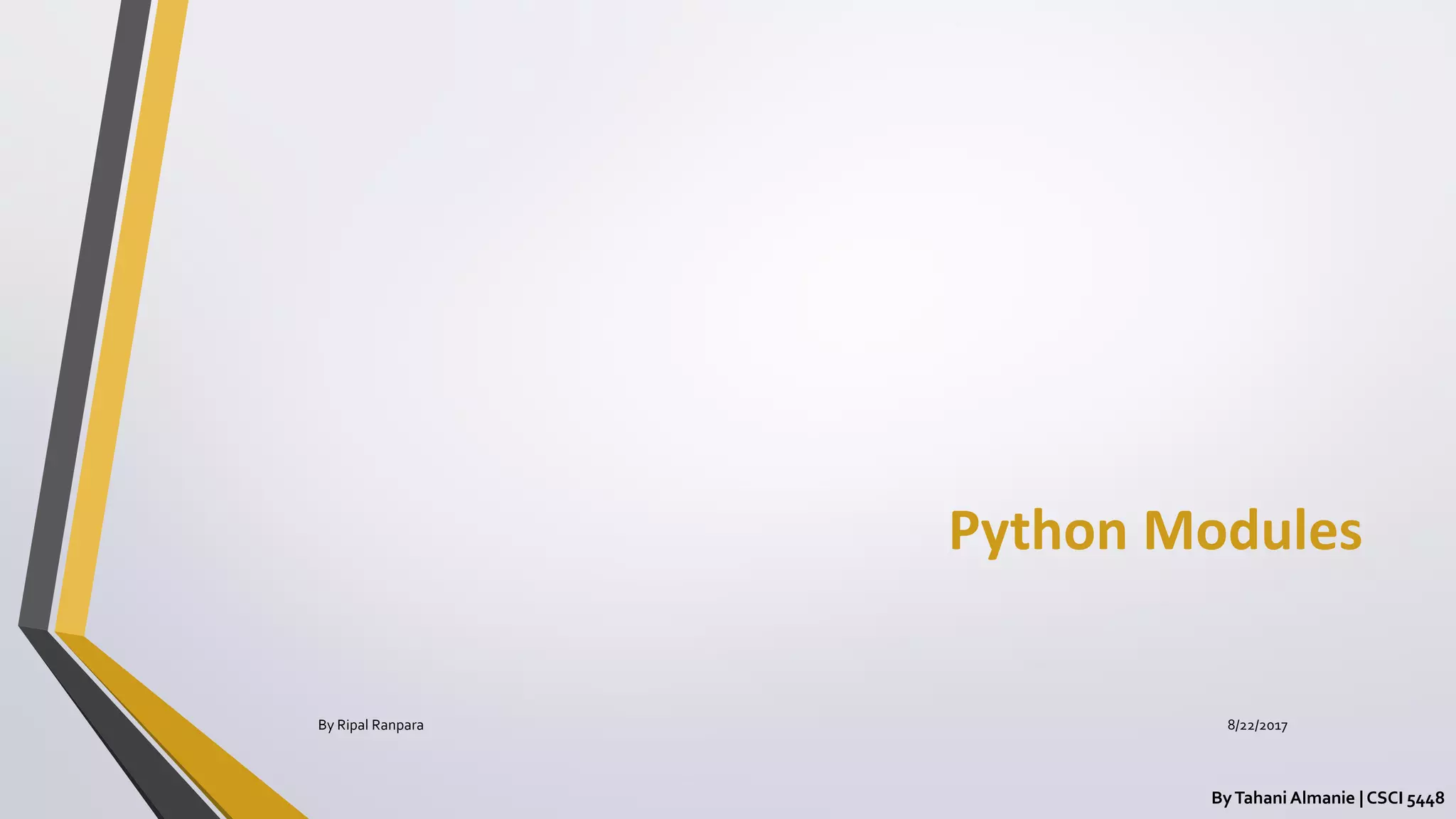
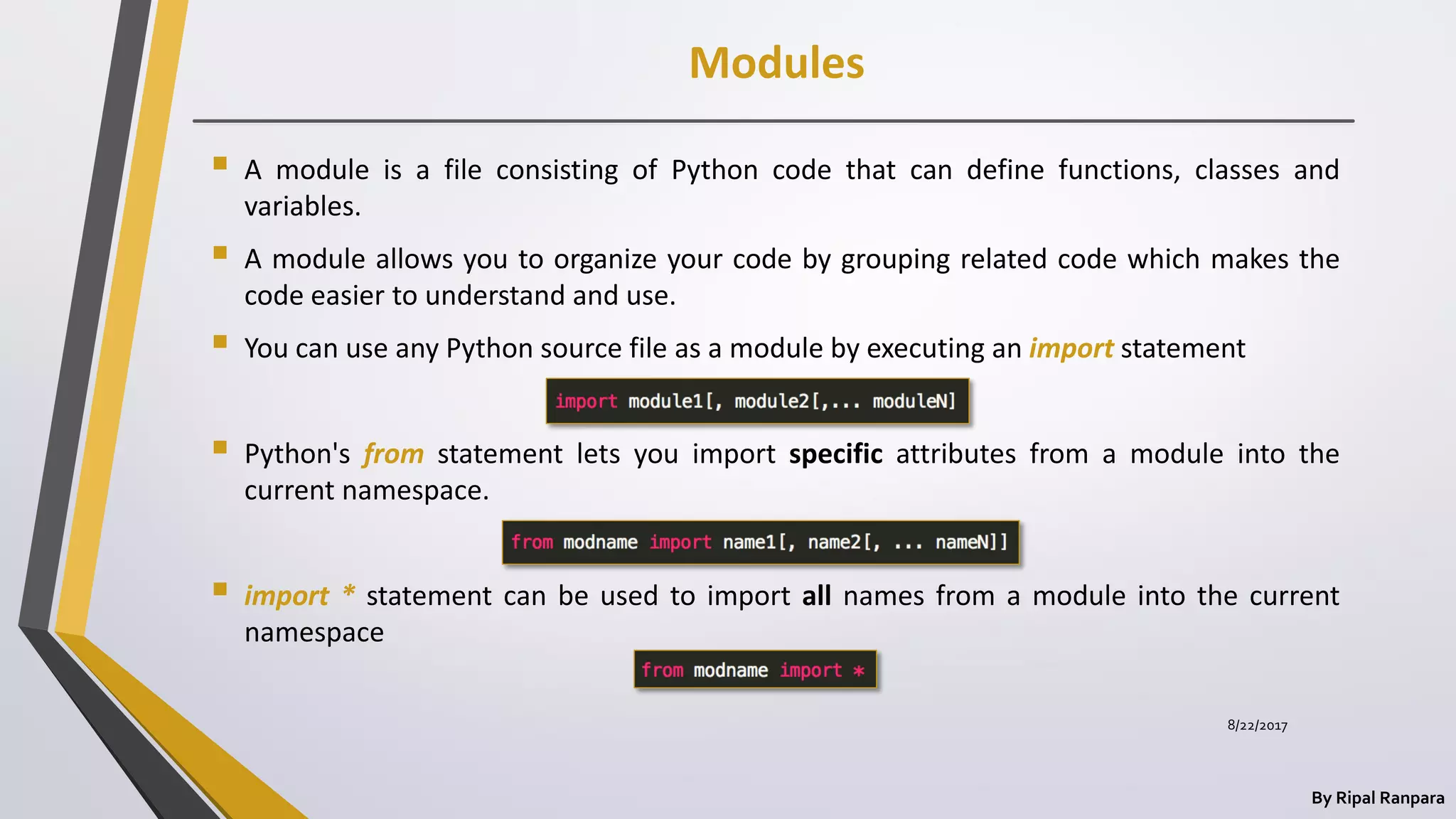

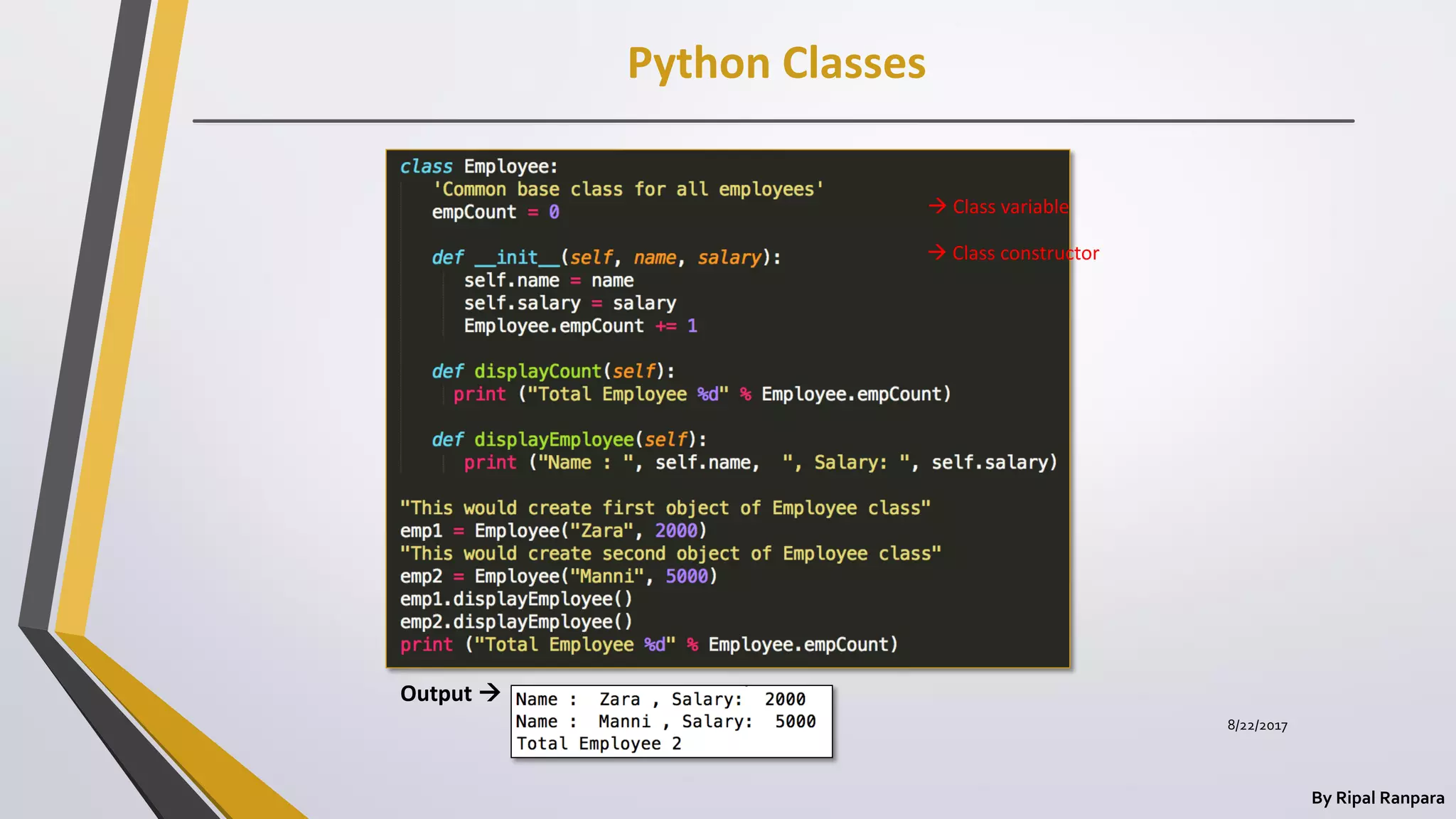
![Python Classes
By Ripal Ranpara
Built-in class functions
• getattr(obj, name[, default]) : to access the attribute of object.
• hasattr(obj,name) : to check if an attribute exists or not.
• setattr(obj,name,value) : to set an attribute. If attribute does not exist, then it
would be created.
• delattr(obj, name) : to delete an attribute.
Data Hiding
You need to name attributes with a double underscore prefix, and those
attributes then are not be directly visible to outsiders.
8/22/2017](https://image.slidesharecdn.com/pythonfinalppt-170822121204-191113054811/75/Pythonfinalppt-170822121204-58-2048.jpg)
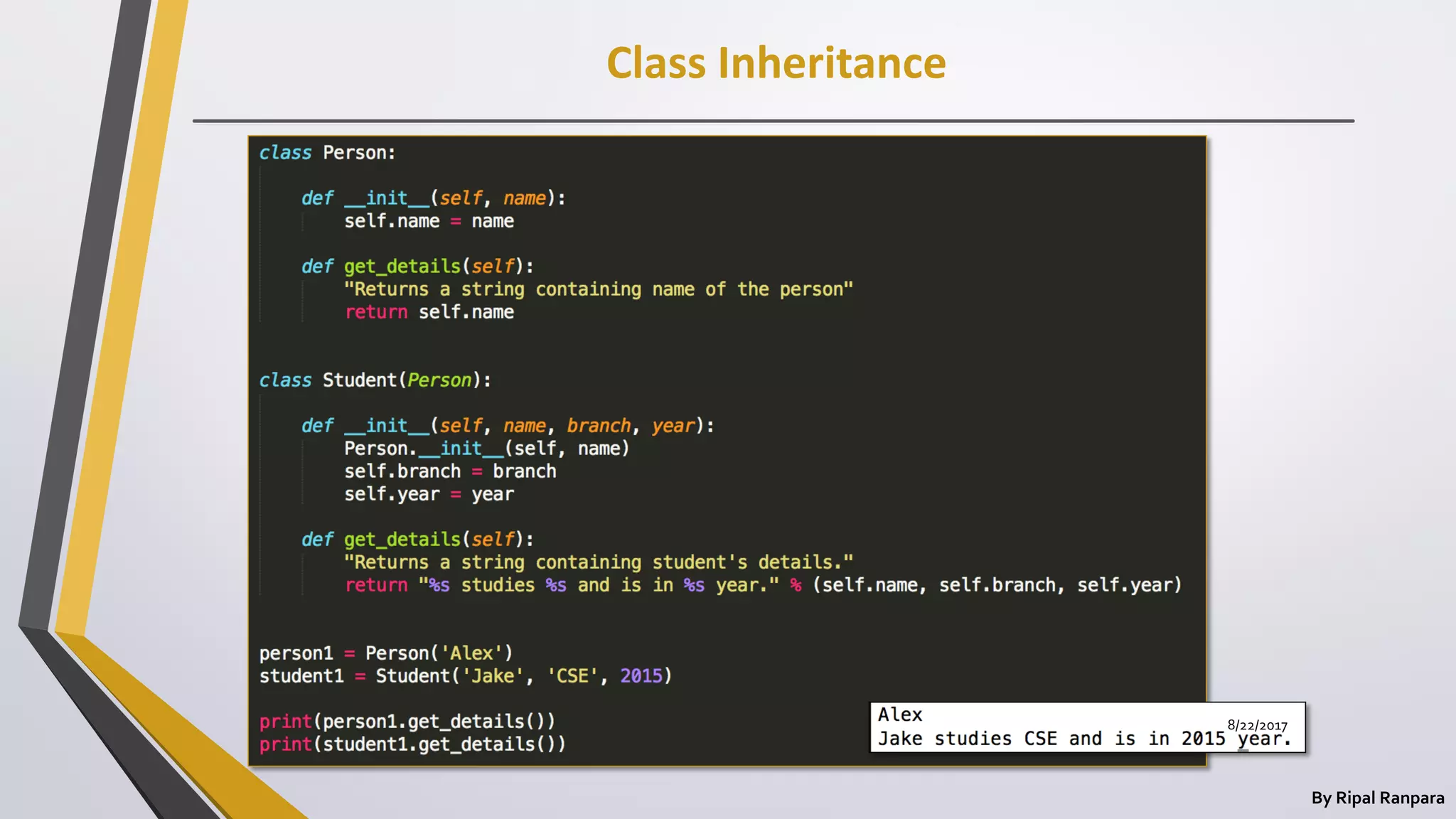
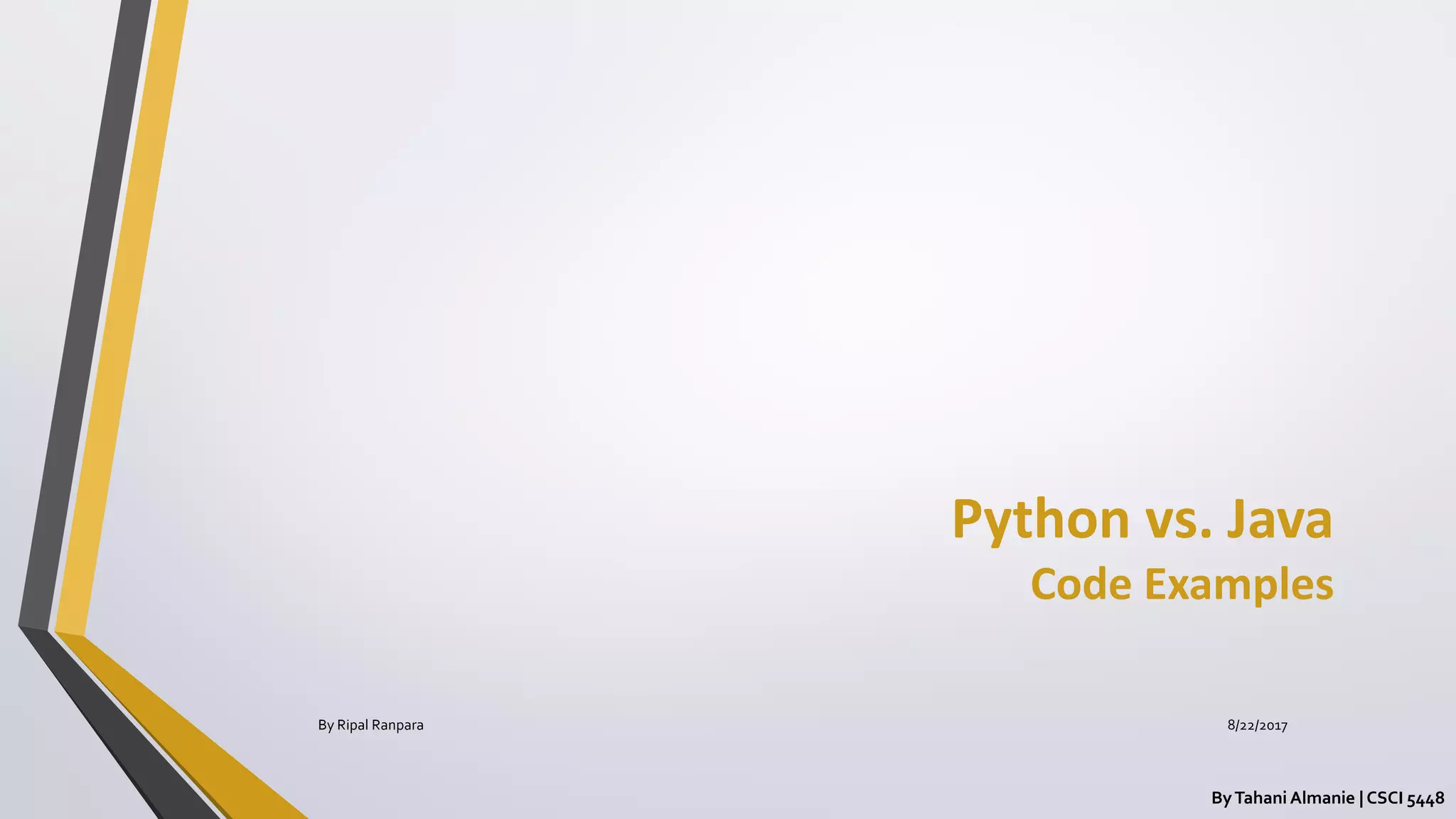
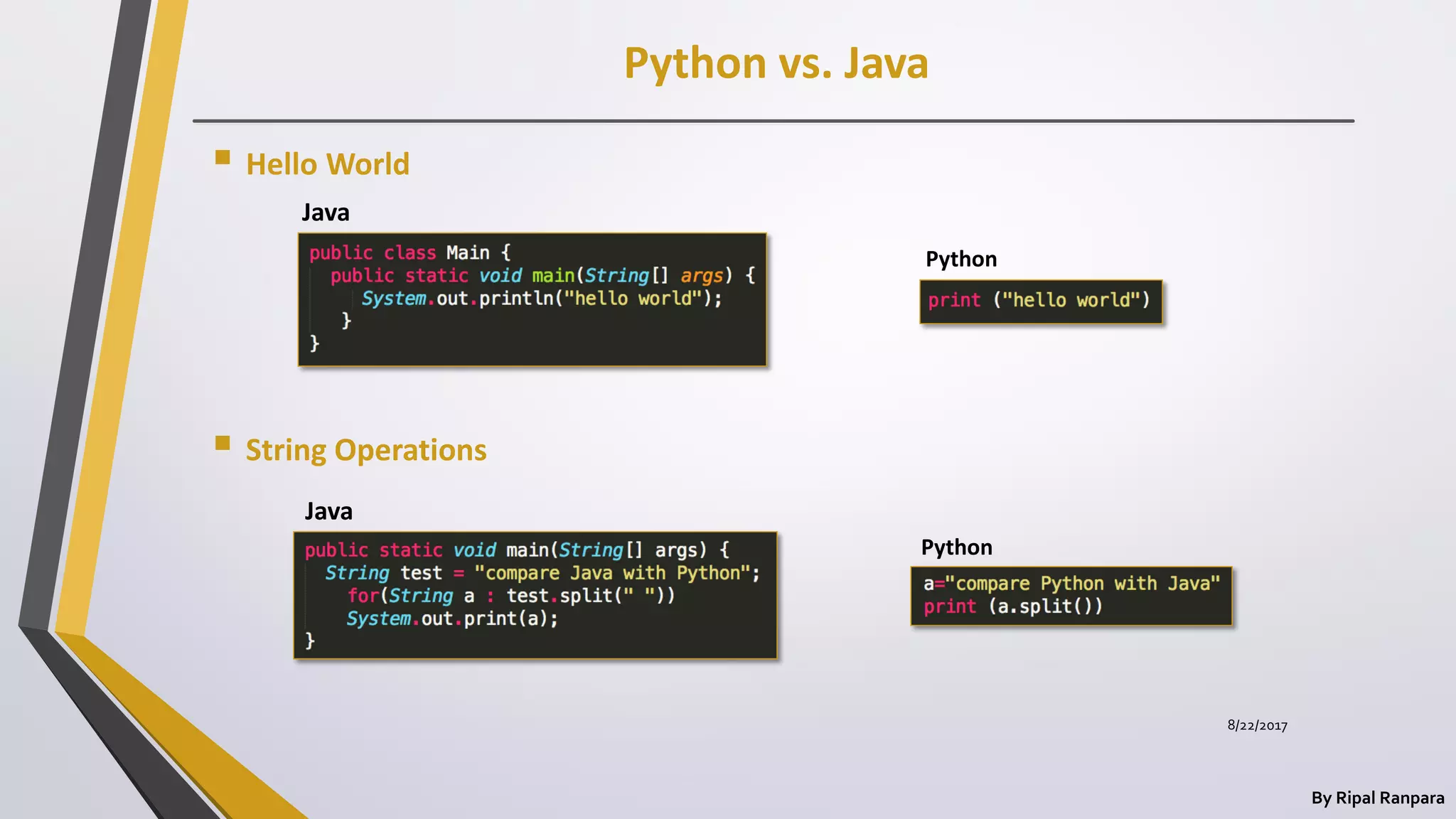


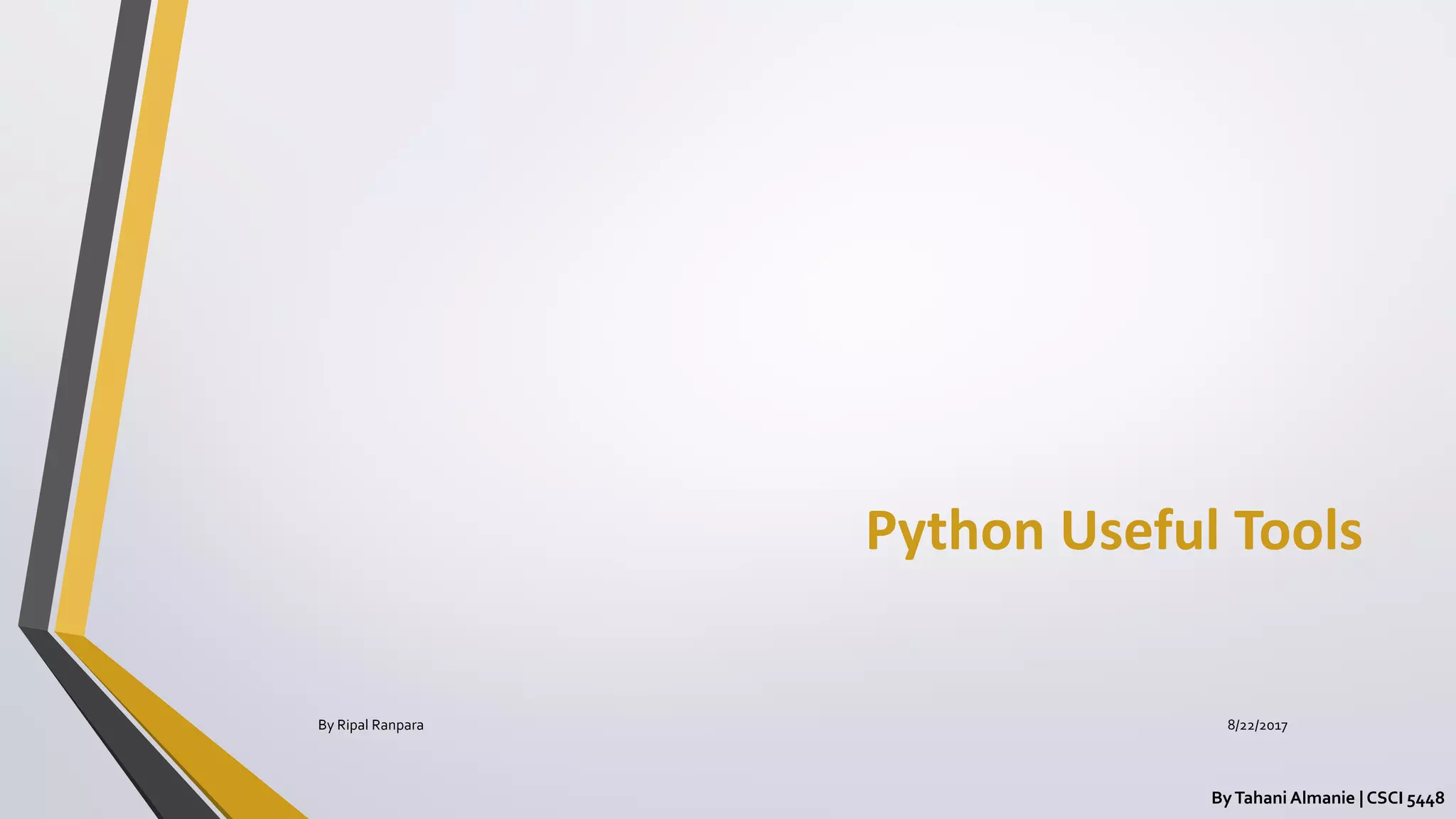
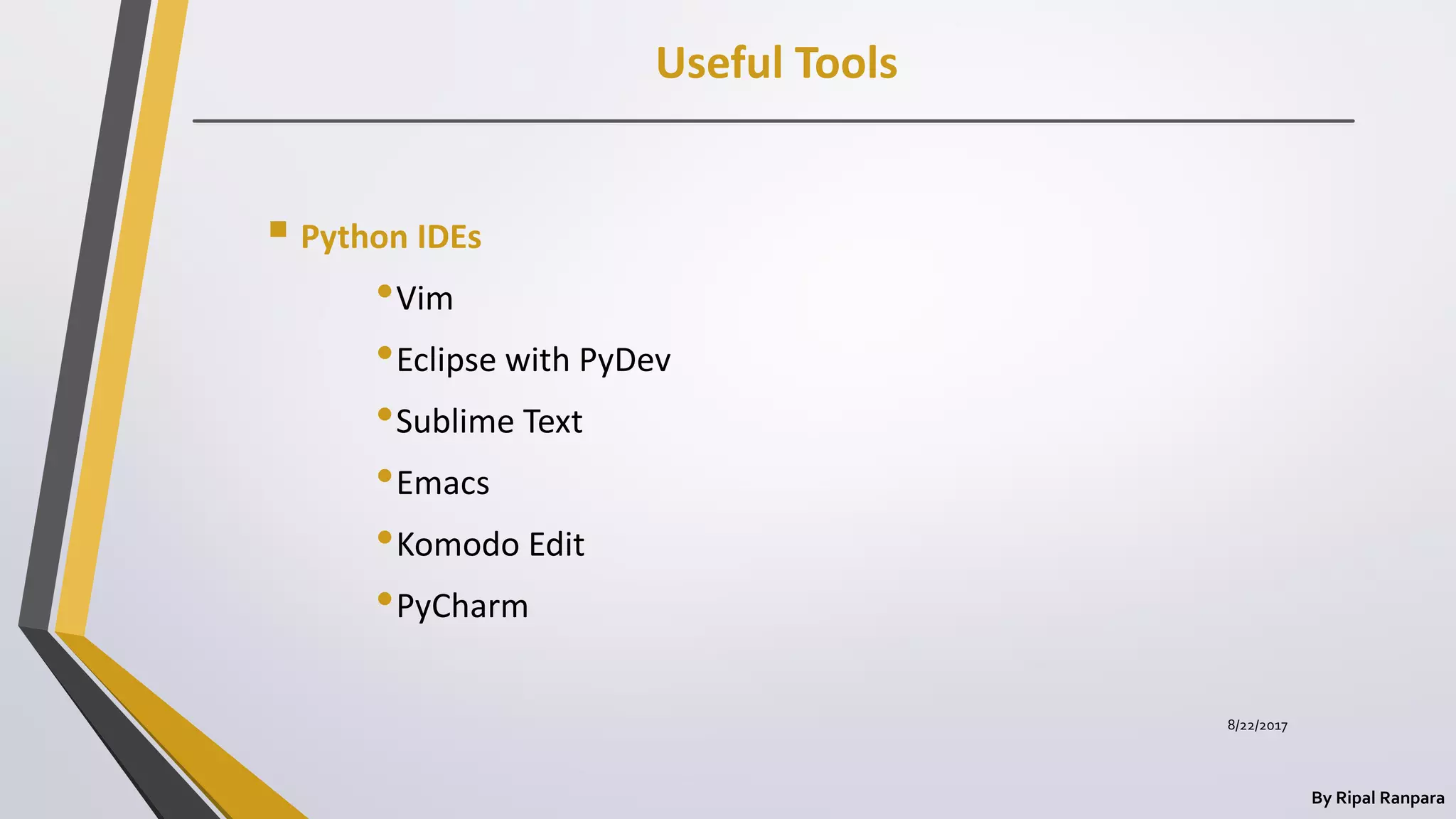
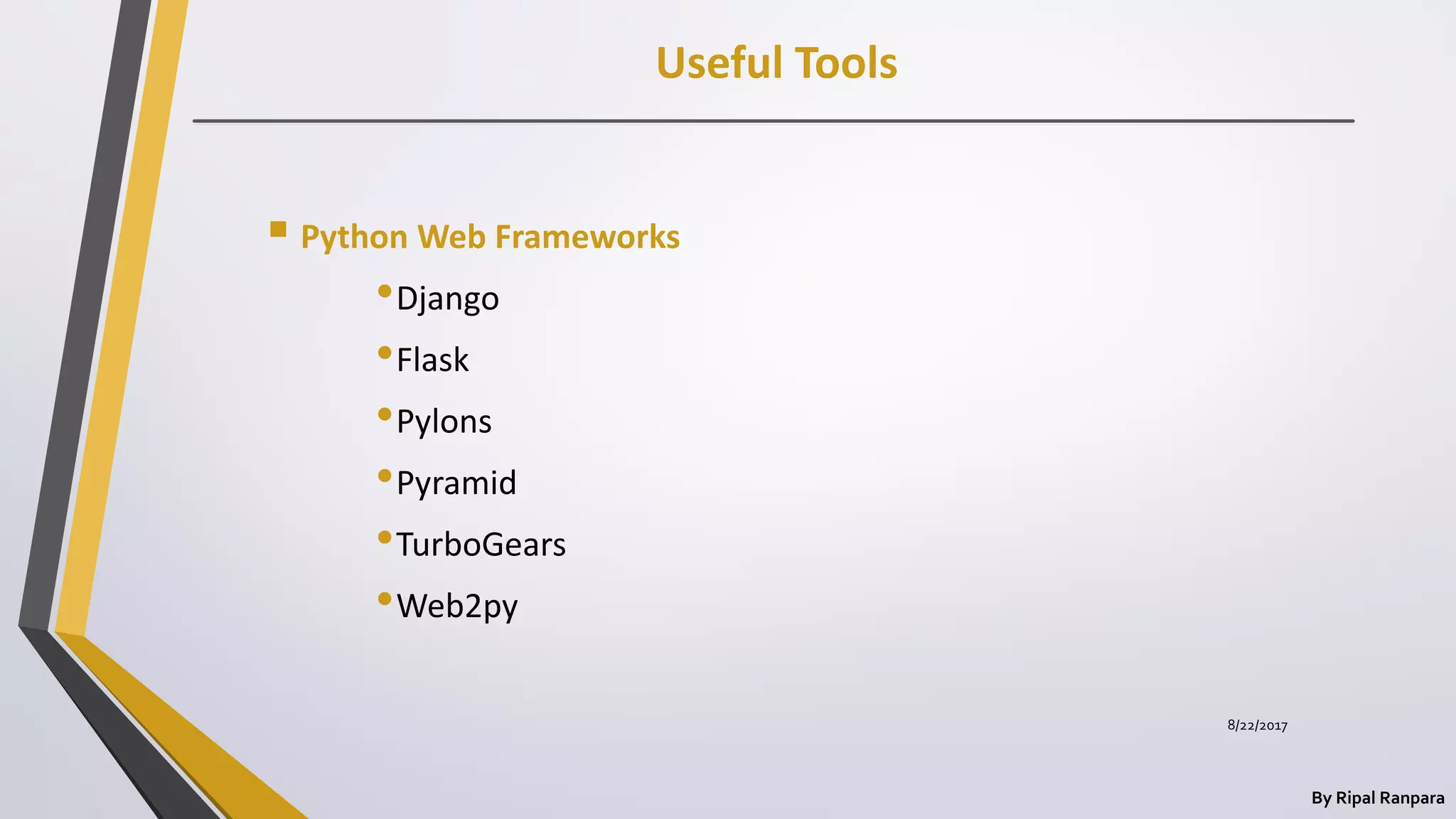
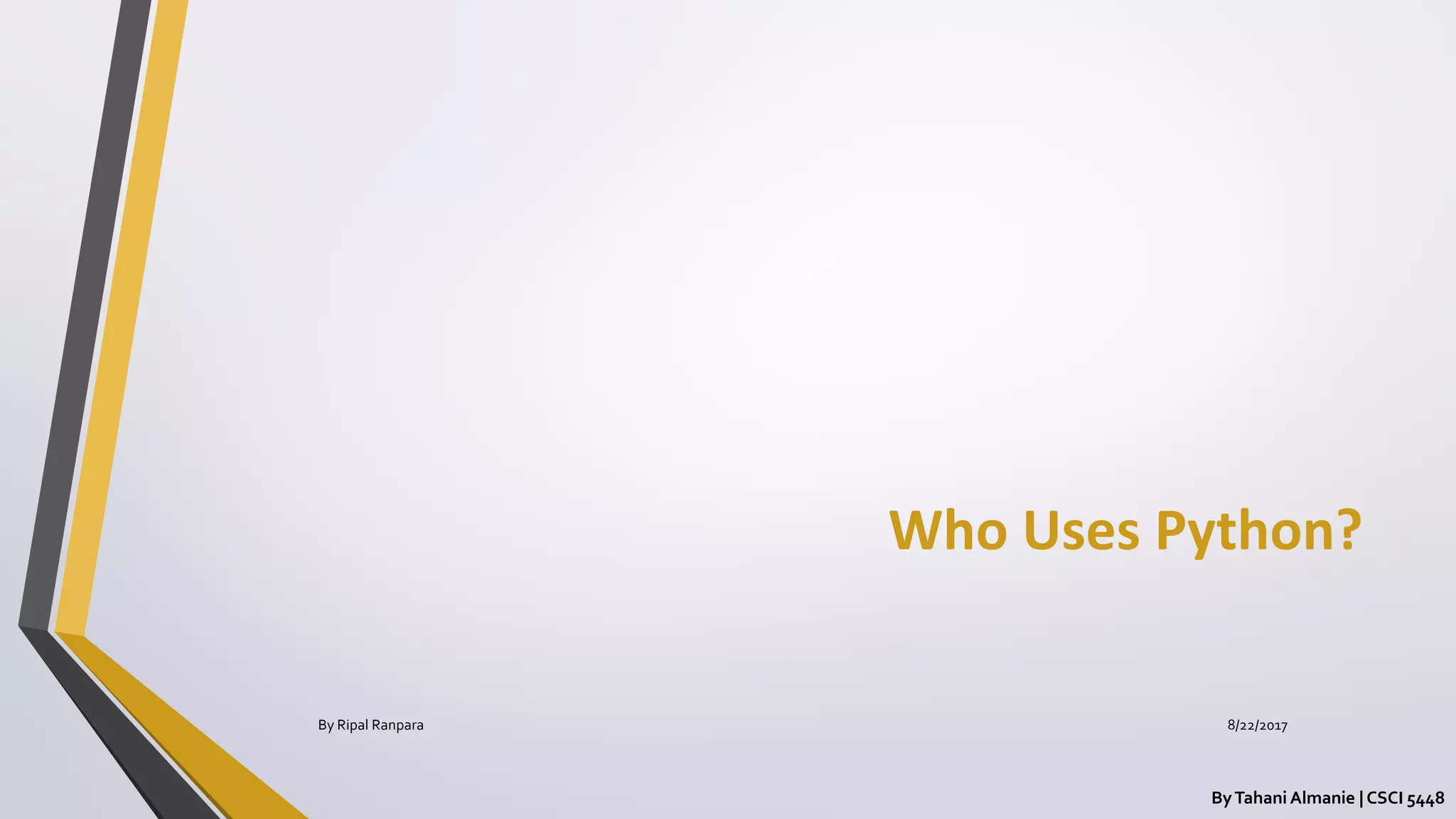

![References
By Ripal Ranpara
[1] Python-course.eu, 'Python3 Tutorial: Python Online Course', 2015. [Online]. Available:
http://www.python-course.eu/python3_course.php.
[2] www.tutorialspoint.com, 'Python tutorial', 2015. [Online]. Available:
http://www.tutorialspoint.com/python/index.htm.
[3] Wikipedia, 'History of Python', 2015. [Online]. Available:
https://en.wikipedia.org/wiki/History_of_Python#Version_release_dates.
[4] Docs.python.org, 'What's New In Python 3.0’, 2015. [Online]. Available:
https://docs.python.org/3/whatsnew/3.0.html.
[5] Sebastianraschka.com, 'Python 2.7.x and Python 3.x key differences', 2015. [Online]. Available:
http://sebastianraschka.com/Articles/2014_python_2_3_key_diff.html.
[6] Programcreek.com, 'Java vs. Python: Why Python can be more productive?', 2015. [Online].
Available: http://www.programcreek.com/2012/04/java-vs-python-why-python-can-be-more-
productive/.
8/22/2017](https://image.slidesharecdn.com/pythonfinalppt-170822121204-191113054811/75/Pythonfinalppt-170822121204-69-2048.jpg)
![References
By Ripal Ranpara
[7] Stsdas.stsci.edu, 'A Quick Tour of Python', 2015. [Online]. Available:
http://stsdas.stsci.edu/pyraf/python_quick_tour.html.
[8] Lynda.com - A LinkedIn Company, 'Python 3 Essential Training | Lynda.com Training', 2015.
[Online]. Available: http://www.lynda.com/Python-3-tutorials/essential-training/62226-2.html.
[9] Pymbook.readthedocs.org, 'Welcome to Python for you and me — Python for you and me
0.3.alpha1 documentation', 2015. [Online]. Available:
http://pymbook.readthedocs.org/en/latest/index.html.
[10] Code Geekz, '10 Best Python IDE for Developers | Code Geekz', 2014. [Online]. Available:
https://codegeekz.com/best-python-ide-for-developers/.
[11] K. Radhakrishnan, 'Top 10 Python Powered Web Frameworks For Developers',
Toppersworld.com, 2014. [Online]. Available: http://toppersworld.com/top-10-python-powered-web-
frameworks-for-developers/.
[12] Wiki.python.org, 'OrganizationsUsingPython - Python Wiki', 2015. [Online]. Available:
https://wiki.python.org/moin/OrganizationsUsingPython. 8/22/2017](https://image.slidesharecdn.com/pythonfinalppt-170822121204-191113054811/75/Pythonfinalppt-170822121204-70-2048.jpg)
